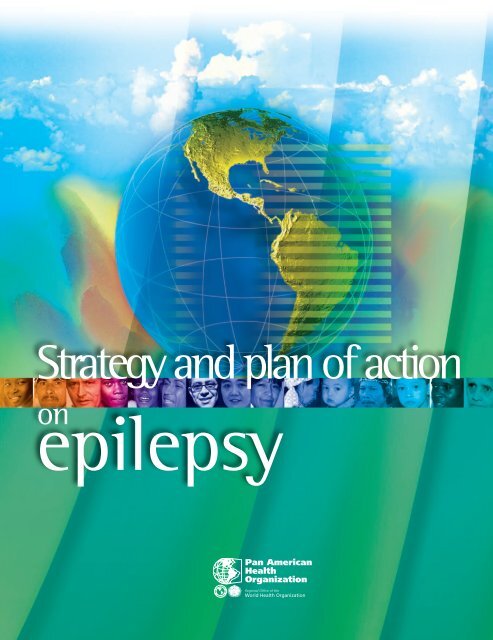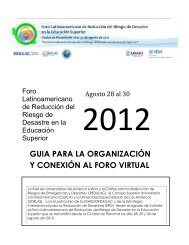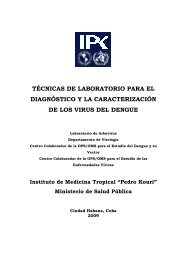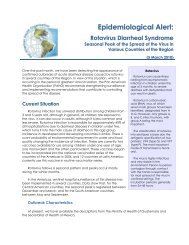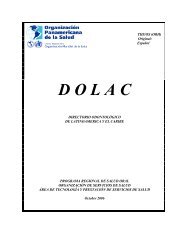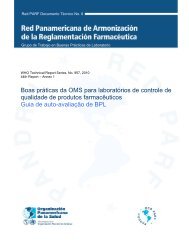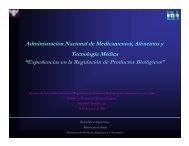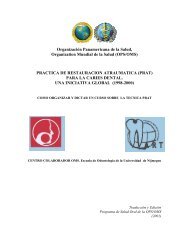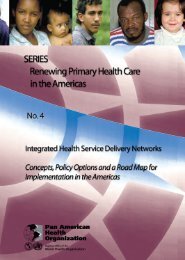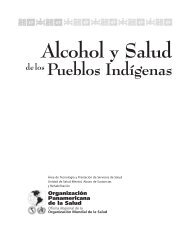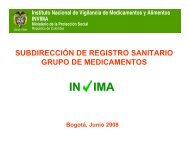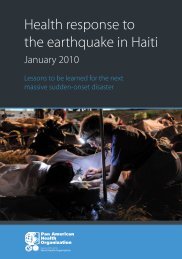Strategy and Plan of Action on Epilepsy - PAHO/WHO
Strategy and Plan of Action on Epilepsy - PAHO/WHO
Strategy and Plan of Action on Epilepsy - PAHO/WHO
You also want an ePaper? Increase the reach of your titles
YUMPU automatically turns print PDFs into web optimized ePapers that Google loves.
<str<strong>on</strong>g>Strategy</str<strong>on</strong>g> <str<strong>on</strong>g>and</str<strong>on</strong>g> plan <str<strong>on</strong>g>of</str<strong>on</strong>g> acti<strong>on</strong><br />
<strong>on</strong><br />
epilepsy
<str<strong>on</strong>g>Strategy</str<strong>on</strong>g> <str<strong>on</strong>g>and</str<strong>on</strong>g> <str<strong>on</strong>g>Plan</str<strong>on</strong>g> <str<strong>on</strong>g>of</str<strong>on</strong>g> <str<strong>on</strong>g>Acti<strong>on</strong></str<strong>on</strong>g> <strong>on</strong><br />
<strong>Epilepsy</strong><br />
525 Twenty-third St., NW<br />
Washingt<strong>on</strong>, DC 20037, USA<br />
www.paho.org<br />
3
Introducti<strong>on</strong><br />
51 st DIRECTING COUNCIL<br />
63 rd SESSION OF THE REGIONAL COMMITTEE<br />
CD51/10, Rev. 1 (Eng.)<br />
Washingt<strong>on</strong>, D.C., USA, 26-30 September 2011<br />
CD51/10, Rev. 1 (Eng.) /ORIGINAL: SPANISH<br />
<str<strong>on</strong>g>Strategy</str<strong>on</strong>g> <str<strong>on</strong>g>and</str<strong>on</strong>g> <str<strong>on</strong>g>Plan</str<strong>on</strong>g> <str<strong>on</strong>g>of</str<strong>on</strong>g> <str<strong>on</strong>g>Acti<strong>on</strong></str<strong>on</strong>g> <strong>on</strong><br />
<strong>Epilepsy</strong><br />
1. <strong>Epilepsy</strong> is <strong>on</strong>e <str<strong>on</strong>g>of</str<strong>on</strong>g> the world’s most comm<strong>on</strong> chr<strong>on</strong>ic neurological disorders. Roughly 50 milli<strong>on</strong> people<br />
suffer from it, 5 milli<strong>on</strong> <str<strong>on</strong>g>of</str<strong>on</strong>g> them in the Regi<strong>on</strong> <str<strong>on</strong>g>of</str<strong>on</strong>g> the Americas (1-5). Nevertheless, it is estimated that over<br />
50% <str<strong>on</strong>g>of</str<strong>on</strong>g> these people in Latin America <str<strong>on</strong>g>and</str<strong>on</strong>g> the Caribbean have no access to services (2, 6-9). Furthermore,<br />
the stigma attached to people with epilepsy is a barrier to the exercise <str<strong>on</strong>g>of</str<strong>on</strong>g> their human rights <str<strong>on</strong>g>and</str<strong>on</strong>g> social<br />
integrati<strong>on</strong> (1-2, 10-11).<br />
2. It is important to note that scientific advances have improved the underst<str<strong>on</strong>g>and</str<strong>on</strong>g>ing <str<strong>on</strong>g>and</str<strong>on</strong>g> management <str<strong>on</strong>g>of</str<strong>on</strong>g><br />
epilepsy. This fact, combined with political will, makes this the right time for the Pan American Health<br />
Organizati<strong>on</strong> (<strong>PAHO</strong>) <str<strong>on</strong>g>and</str<strong>on</strong>g> its Member States to make this important public health problem a priority.<br />
3. This document includes the input received from a c<strong>on</strong>sultative process in which the Internati<strong>on</strong>al League<br />
against <strong>Epilepsy</strong> (ILAE), the Internati<strong>on</strong>al Bureau for <strong>Epilepsy</strong> (IBE), the ministries <str<strong>on</strong>g>of</str<strong>on</strong>g> health, <str<strong>on</strong>g>and</str<strong>on</strong>g> other<br />
nati<strong>on</strong>al organizati<strong>on</strong>s, the Department <str<strong>on</strong>g>of</str<strong>on</strong>g> Mental Health <str<strong>on</strong>g>and</str<strong>on</strong>g> Substance Abuse <str<strong>on</strong>g>of</str<strong>on</strong>g> the World Health<br />
Organizati<strong>on</strong> (<strong>WHO</strong>), <strong>PAHO</strong> technical programs, <str<strong>on</strong>g>and</str<strong>on</strong>g> as a group <str<strong>on</strong>g>of</str<strong>on</strong>g> experts participated.<br />
Background<br />
4. Various <strong>PAHO</strong> <str<strong>on</strong>g>and</str<strong>on</strong>g> <strong>WHO</strong> program documents <str<strong>on</strong>g>and</str<strong>on</strong>g> resoluti<strong>on</strong>s serve as the background <str<strong>on</strong>g>and</str<strong>on</strong>g> underpinnings<br />
for this strategy <str<strong>on</strong>g>and</str<strong>on</strong>g> plan <str<strong>on</strong>g>of</str<strong>on</strong>g> acti<strong>on</strong>.<br />
5. The Global Campaign against <strong>Epilepsy</strong>: Out <str<strong>on</strong>g>of</str<strong>on</strong>g> the Shadows (10) was <str<strong>on</strong>g>of</str<strong>on</strong>g>ficially launched in 1997 in Geneva,<br />
Switzerl<str<strong>on</strong>g>and</str<strong>on</strong>g>, through an agreement am<strong>on</strong>g <strong>WHO</strong>, the ILAE, <str<strong>on</strong>g>and</str<strong>on</strong>g> the IBE. In 2000, the Declarati<strong>on</strong> <str<strong>on</strong>g>of</str<strong>on</strong>g><br />
Santiago <strong>on</strong> <strong>Epilepsy</strong> in Latin America was adopted in Chile (12). In 2005, a declarati<strong>on</strong> <strong>on</strong> this subject<br />
was also issued in the United States. In 2008, with support from the ILAE <str<strong>on</strong>g>and</str<strong>on</strong>g> the IBE, <strong>PAHO</strong> published<br />
the report Informe sobre la Epilepsia en Latinoamérica [Report <strong>on</strong> <strong>Epilepsy</strong> in Latin America] (2).<br />
6. The countries <str<strong>on</strong>g>of</str<strong>on</strong>g> the Regi<strong>on</strong> adopted the Health Agenda for the Americas 2008 2017 (13). The 48th<br />
Directing Council <str<strong>on</strong>g>of</str<strong>on</strong>g> <strong>PAHO</strong> (2008) approved the Strategic <str<strong>on</strong>g>Plan</str<strong>on</strong>g> 2008-2012 (14), in which Strategic<br />
Objective 3 focuses <strong>on</strong> chr<strong>on</strong>ic n<strong>on</strong>communicable diseases.<br />
1
<str<strong>on</strong>g>Strategy</str<strong>on</strong>g> <str<strong>on</strong>g>and</str<strong>on</strong>g> <str<strong>on</strong>g>Plan</str<strong>on</strong>g> <str<strong>on</strong>g>of</str<strong>on</strong>g> <str<strong>on</strong>g>Acti<strong>on</strong></str<strong>on</strong>g> <strong>on</strong> <strong>Epilepsy</strong><br />
7. The Directing Council <str<strong>on</strong>g>of</str<strong>on</strong>g> <strong>PAHO</strong> has approved technical documents <str<strong>on</strong>g>and</str<strong>on</strong>g> adopted resoluti<strong>on</strong>s in different<br />
years <strong>on</strong> issues related to epilepsy. These include: (a) Disability: Preventi<strong>on</strong> <str<strong>on</strong>g>and</str<strong>on</strong>g> Rehabilitati<strong>on</strong> in the<br />
C<strong>on</strong>text <str<strong>on</strong>g>of</str<strong>on</strong>g> the Right to the Enjoyment <str<strong>on</strong>g>of</str<strong>on</strong>g> the Highest Attainable St<str<strong>on</strong>g>and</str<strong>on</strong>g>ard <str<strong>on</strong>g>of</str<strong>on</strong>g> Physical <str<strong>on</strong>g>and</str<strong>on</strong>g> Mental Health<br />
<str<strong>on</strong>g>and</str<strong>on</strong>g> Other Related Rights (2006) (15); (b) <str<strong>on</strong>g>Strategy</str<strong>on</strong>g> <str<strong>on</strong>g>and</str<strong>on</strong>g> <str<strong>on</strong>g>Plan</str<strong>on</strong>g> <str<strong>on</strong>g>of</str<strong>on</strong>g> <str<strong>on</strong>g>Acti<strong>on</strong></str<strong>on</strong>g> <strong>on</strong> Mental Health (2009) (16); <str<strong>on</strong>g>and</str<strong>on</strong>g><br />
(c) Health <str<strong>on</strong>g>and</str<strong>on</strong>g> Human Rights (2010) (17).<br />
8. In 2008, <strong>WHO</strong> <str<strong>on</strong>g>of</str<strong>on</strong>g>ficially launched the Mental Health Gap <str<strong>on</strong>g>Acti<strong>on</strong></str<strong>on</strong>g> Program (mhGAP) (18), which<br />
recognized epilepsy as <strong>on</strong>e <str<strong>on</strong>g>of</str<strong>on</strong>g> the eight priority c<strong>on</strong>diti<strong>on</strong>s. In 2010 it published the mhGAP Interventi<strong>on</strong><br />
Guide for Mental, Neurological <str<strong>on</strong>g>and</str<strong>on</strong>g> Substance Use Disorders in N<strong>on</strong>-specialized Health Settings (mhGAP-<br />
IG), disorders that include epilepsy (19).<br />
Situati<strong>on</strong> Analysis<br />
9. Diagnosing epilepsy is essentially a clinical process that can be performed in n<strong>on</strong>specialized health settings<br />
by taking a good clinical history <str<strong>on</strong>g>and</str<strong>on</strong>g> performing an examinati<strong>on</strong>; an internati<strong>on</strong>al classificati<strong>on</strong> is available<br />
that facilitates diagnosis (20, 21). <strong>Epilepsy</strong> may be caused by genetic, structural, metabolic, or unknown<br />
factors (21). Am<strong>on</strong>g the structural factors, the most comm<strong>on</strong> causes in Latin America <str<strong>on</strong>g>and</str<strong>on</strong>g> the Caribbean are<br />
infectious <str<strong>on</strong>g>and</str<strong>on</strong>g> parasitic diseases (especially, neurocysticercosis), perinatal brain damage, vascular diseases, <str<strong>on</strong>g>and</str<strong>on</strong>g><br />
head trauma, all <str<strong>on</strong>g>of</str<strong>on</strong>g> which are preventable (1-3).<br />
10. Neurocysticercosis is an infecti<strong>on</strong> <str<strong>on</strong>g>of</str<strong>on</strong>g> the nervous system caused by the Taenia solium larva. Its most comm<strong>on</strong><br />
clinical manifestati<strong>on</strong>s are acute symptomatic epileptic crises <str<strong>on</strong>g>and</str<strong>on</strong>g> epilepsy. According to some Latin American<br />
studies, community health <str<strong>on</strong>g>and</str<strong>on</strong>g> educati<strong>on</strong> interventi<strong>on</strong>s can reduce the incidence <str<strong>on</strong>g>of</str<strong>on</strong>g> epilepsy caused by<br />
neurocysticercosis in hyperendemic populati<strong>on</strong>s (22, 23).<br />
11. The prognosis in cases <str<strong>on</strong>g>of</str<strong>on</strong>g> epilepsy depends <strong>on</strong> the etiology <str<strong>on</strong>g>of</str<strong>on</strong>g> the illness, as well as early <str<strong>on</strong>g>and</str<strong>on</strong>g>sustained treatment.<br />
It is estimated that up to 70% <str<strong>on</strong>g>of</str<strong>on</strong>g> people with epilepsy can live normal lives if they receive proper care (1).<br />
Burden, Prevalence, <str<strong>on</strong>g>and</str<strong>on</strong>g> Mortality<br />
12. <strong>Epilepsy</strong> accounts for 0.5% <str<strong>on</strong>g>of</str<strong>on</strong>g> the global burden <str<strong>on</strong>g>of</str<strong>on</strong>g> disease, measured in disability-adjusted life years (DALYs),<br />
with 80% <str<strong>on</strong>g>of</str<strong>on</strong>g> that burden corresp<strong>on</strong>ding to the developing countries (1). This disorder accounts for 0.7% <str<strong>on</strong>g>of</str<strong>on</strong>g><br />
the regi<strong>on</strong>al burden <str<strong>on</strong>g>of</str<strong>on</strong>g> disease; the distributi<strong>on</strong> by sex does not yield significant differences, <str<strong>on</strong>g>and</str<strong>on</strong>g> the highest<br />
burden, 2.8%, is found in the 5 14 age group. At 0.4%, the United States <str<strong>on</strong>g>and</str<strong>on</strong>g> Canada have a lower burden<br />
than Latin America <str<strong>on</strong>g>and</str<strong>on</strong>g> the Caribbean, where the figure is 0.9%.<br />
13. The global epilepsy incidence, prevalence, <str<strong>on</strong>g>and</str<strong>on</strong>g> mortality indexes are not uniform <str<strong>on</strong>g>and</str<strong>on</strong>g> are dependent <strong>on</strong><br />
several factors (1). According to a series 32 <str<strong>on</strong>g>of</str<strong>on</strong>g> community-based studies, the lifel<strong>on</strong>g prevalence in Latin<br />
America <str<strong>on</strong>g>and</str<strong>on</strong>g> the Caribbean st<str<strong>on</strong>g>and</str<strong>on</strong>g>s at an average <str<strong>on</strong>g>of</str<strong>on</strong>g> 17.8 per 1,000 populati<strong>on</strong> (range: 6-43.2). There were no<br />
significant differences by sex or age group (24).<br />
14. Mortality rates am<strong>on</strong>g people with epilepsy are higher than for the general populati<strong>on</strong>. The estimated annual<br />
global mortality rate ranges from 1 to 8 per 100,000 populati<strong>on</strong> (1, 2). A regi<strong>on</strong>al mortality study that ran<br />
from 1999 to 2007 found an annual average <str<strong>on</strong>g>of</str<strong>on</strong>g> 7,179 deaths from epilepsy (as the primary cause), a rate <str<strong>on</strong>g>of</str<strong>on</strong>g><br />
0.8 per 100,000 populati<strong>on</strong>, with a higher index in men (1.0) than women (0.60). In the groups aged 20-59<br />
<str<strong>on</strong>g>and</str<strong>on</strong>g> over 60, the highest rates <str<strong>on</strong>g>of</str<strong>on</strong>g> 1.0 <str<strong>on</strong>g>and</str<strong>on</strong>g> 1.2, respectively, are reported. The mortality index in Latin America<br />
<str<strong>on</strong>g>and</str<strong>on</strong>g> the Caribbean is 1.1, higher than that <str<strong>on</strong>g>of</str<strong>on</strong>g> the United States <str<strong>on</strong>g>and</str<strong>on</strong>g> Canada, which is 0.4 (25). It is believed<br />
that there is significant underreporting in some countries.<br />
2
51. st Directing Council / 63 .rd Sessi<strong>on</strong> <str<strong>on</strong>g>of</str<strong>on</strong>g> the Regi<strong>on</strong>al Committee<br />
15. A recent study <str<strong>on</strong>g>of</str<strong>on</strong>g> the treatment gap yielded a figure <str<strong>on</strong>g>of</str<strong>on</strong>g> 75% in low-income countries <str<strong>on</strong>g>and</str<strong>on</strong>g> over 50% in the<br />
majority <str<strong>on</strong>g>of</str<strong>on</strong>g> middle-income countries (6-8).<br />
Role <str<strong>on</strong>g>of</str<strong>on</strong>g> Auxiliary Diagnostic Tools<br />
16. The electroencephalogram (EEG) is a useful tool for the diagnosis <str<strong>on</strong>g>and</str<strong>on</strong>g> classificati<strong>on</strong> <str<strong>on</strong>g>of</str<strong>on</strong>g> epileptic syndromes.<br />
Access to the EEG is limited in many countries, <str<strong>on</strong>g>and</str<strong>on</strong>g> electroencephalographic video m<strong>on</strong>itoring is available at<br />
<strong>on</strong>ly a few specialized centers (2).<br />
17. Computerized axial tomography (CAT) remains a useful tool, owing given its low cost <str<strong>on</strong>g>and</str<strong>on</strong>g> ability to detect<br />
obvious lesi<strong>on</strong>s such as the calcificati<strong>on</strong>s from neurocysticercosis (26). Magnetic res<strong>on</strong>ance imaging (MRI)<br />
<str<strong>on</strong>g>of</str<strong>on</strong>g> the brain is recommended as the technique <str<strong>on</strong>g>of</str<strong>on</strong>g> choice for identifying the most comm<strong>on</strong> etiologies in<br />
epilepsy (27). However, neuroimaging equipment in Latin America <str<strong>on</strong>g>and</str<strong>on</strong>g> the Caribbean is rare <str<strong>on</strong>g>and</str<strong>on</strong>g> is usually<br />
c<strong>on</strong>centrated in the private sector, in additi<strong>on</strong> to being unaffordable to the majority <str<strong>on</strong>g>of</str<strong>on</strong>g> the populati<strong>on</strong> (2).<br />
Treatment <str<strong>on</strong>g>and</str<strong>on</strong>g> Rehabilitati<strong>on</strong><br />
18. The majority <str<strong>on</strong>g>of</str<strong>on</strong>g> countries in Latin America <str<strong>on</strong>g>and</str<strong>on</strong>g> the Caribbean have the four basic drugs in their arsenal<br />
(phenobarbital, phenytoin, carbamazepine, <str<strong>on</strong>g>and</str<strong>on</strong>g> valproic acid), but <strong>on</strong>ly at the sec<strong>on</strong>dary <str<strong>on</strong>g>and</str<strong>on</strong>g> tertiary levels<br />
<str<strong>on</strong>g>of</str<strong>on</strong>g> care. Ensuring the supply <str<strong>on</strong>g>of</str<strong>on</strong>g> these four antiepileptics is essential, when we c<strong>on</strong>sider that seizures can be<br />
c<strong>on</strong>trolled with m<strong>on</strong>otherapy regimens in up to 70% <str<strong>on</strong>g>of</str<strong>on</strong>g> cases. In 1990, <strong>WHO</strong> determined that the average<br />
cost <str<strong>on</strong>g>of</str<strong>on</strong>g> medicati<strong>on</strong> (with phenobarbital) could be as low as US$ 5 per patient per year (1).<br />
19. Public services in most Latin American <str<strong>on</strong>g>and</str<strong>on</strong>g> Caribbean countries do not have new generati<strong>on</strong> antiepileptics, which<br />
are useful in intractable cases but are more expensive. Measurement <str<strong>on</strong>g>of</str<strong>on</strong>g> drug-plasma c<strong>on</strong>centrati<strong>on</strong>s is not performed<br />
<strong>on</strong> a regular basis, even though it is a useful procedure (2, 28).<br />
20. Surgical interventi<strong>on</strong> for epilepsy is an effective treatment <str<strong>on</strong>g>and</str<strong>on</strong>g> is recommended in some cases that cannot be<br />
c<strong>on</strong>trolled with drugs; surgical interventi<strong>on</strong>s may reach some 10% <str<strong>on</strong>g>of</str<strong>on</strong>g> the total (1, 29).<br />
21. In the integrated management <str<strong>on</strong>g>of</str<strong>on</strong>g> people with epilepsy, c<strong>on</strong>siderati<strong>on</strong> <str<strong>on</strong>g>of</str<strong>on</strong>g> psychosocial factors is essential<br />
<str<strong>on</strong>g>and</str<strong>on</strong>g> includes educati<strong>on</strong> for self-management; that is, the measures <str<strong>on</strong>g>and</str<strong>on</strong>g> behaviors that people with epilepsy<br />
should adopt <str<strong>on</strong>g>and</str<strong>on</strong>g> maintain to c<strong>on</strong>trol their illness (30). In some cases, complementary measures can also be<br />
helpful; these include, for example, the use <str<strong>on</strong>g>of</str<strong>on</strong>g> natural products, vitamins, relaxati<strong>on</strong> techniques, a healthy<br />
diet, religious or cultural activities, <str<strong>on</strong>g>and</str<strong>on</strong>g> social support; such measures are acceptable as l<strong>on</strong>g as the patient<br />
c<strong>on</strong>tinues the basic drug therapy (31).<br />
22. The objective <str<strong>on</strong>g>of</str<strong>on</strong>g> rehabilitati<strong>on</strong> is to improve the quality <str<strong>on</strong>g>of</str<strong>on</strong>g> life <str<strong>on</strong>g>of</str<strong>on</strong>g> people with epilepsy <str<strong>on</strong>g>and</str<strong>on</strong>g> integrate them<br />
into society <str<strong>on</strong>g>and</str<strong>on</strong>g> the work envir<strong>on</strong>ment. The interventi<strong>on</strong>s that are selected will depend <strong>on</strong> the complexity <str<strong>on</strong>g>of</str<strong>on</strong>g><br />
the cases; most people with epilepsy enjoy a substantial degree <str<strong>on</strong>g>of</str<strong>on</strong>g> aut<strong>on</strong>omy <str<strong>on</strong>g>and</str<strong>on</strong>g> <strong>on</strong>ly a minority suffers from<br />
serious forms. This group includes pers<strong>on</strong>s with disabilities <str<strong>on</strong>g>and</str<strong>on</strong>g> people who are instituti<strong>on</strong>alized or highly<br />
dependent <strong>on</strong> their families; here, it is essential to develop patients’ social <str<strong>on</strong>g>and</str<strong>on</strong>g> occupati<strong>on</strong>al skills (2).<br />
Programs <str<strong>on</strong>g>and</str<strong>on</strong>g> Services<br />
23. The available data show that <strong>on</strong>ly 34% <str<strong>on</strong>g>of</str<strong>on</strong>g> countries in Latin America <str<strong>on</strong>g>and</str<strong>on</strong>g> the Caribbean reported having<br />
nati<strong>on</strong>al epilepsy programs. (2). Some <str<strong>on</strong>g>of</str<strong>on</strong>g> the key problems in delivering services to people with this disorder<br />
are the limitati<strong>on</strong>s <strong>on</strong> diagnosis, management, <str<strong>on</strong>g>and</str<strong>on</strong>g> m<strong>on</strong>itoring in primary health care. Many countries lack<br />
interventi<strong>on</strong> protocols, or those that they do have are not up-to-date (2).<br />
3
<str<strong>on</strong>g>Strategy</str<strong>on</strong>g> <str<strong>on</strong>g>and</str<strong>on</strong>g> <str<strong>on</strong>g>Plan</str<strong>on</strong>g> <str<strong>on</strong>g>of</str<strong>on</strong>g> <str<strong>on</strong>g>Acti<strong>on</strong></str<strong>on</strong>g> <strong>on</strong> <strong>Epilepsy</strong><br />
24. In the majority countries in Latin America <str<strong>on</strong>g>and</str<strong>on</strong>g> the Caribbean, the sec<strong>on</strong>dary--or specialized--level <str<strong>on</strong>g>of</str<strong>on</strong>g> care has<br />
serious limitati<strong>on</strong>s <str<strong>on</strong>g>and</str<strong>on</strong>g> is sometimes n<strong>on</strong>existent. There is little or no linkage between primary health care<br />
<str<strong>on</strong>g>and</str<strong>on</strong>g> the neurology services (2).<br />
25. The average number <str<strong>on</strong>g>of</str<strong>on</strong>g> neurologists per 100,000 populati<strong>on</strong> in the Regi<strong>on</strong> <str<strong>on</strong>g>of</str<strong>on</strong>g> the Americas is 0.3 (higher than<br />
the global average <str<strong>on</strong>g>of</str<strong>on</strong>g> 0.18) (3). The number varies from country to country, with a very high c<strong>on</strong>centrati<strong>on</strong> in<br />
the capitals <str<strong>on</strong>g>and</str<strong>on</strong>g> major cities (2). Some 76% <str<strong>on</strong>g>of</str<strong>on</strong>g> countries in the Hemisphere report the existence <str<strong>on</strong>g>of</str<strong>on</strong>g> associati<strong>on</strong>s<br />
<str<strong>on</strong>g>of</str<strong>on</strong>g> neurologists <str<strong>on</strong>g>and</str<strong>on</strong>g> other pr<str<strong>on</strong>g>of</str<strong>on</strong>g>essi<strong>on</strong>als working in the field <str<strong>on</strong>g>of</str<strong>on</strong>g> epilepsy (3).<br />
26. Some 92% <str<strong>on</strong>g>of</str<strong>on</strong>g> countries report having EEG <str<strong>on</strong>g>and</str<strong>on</strong>g> electroencephalographic video m<strong>on</strong>itoring equipment.<br />
However, this does not necessarily mean that they can <str<strong>on</strong>g>of</str<strong>on</strong>g>fer full coverage to the populati<strong>on</strong> (2, 3).<br />
27. There is a high proporti<strong>on</strong> <str<strong>on</strong>g>of</str<strong>on</strong>g> psychiatric comorbidity with epilepsy that <str<strong>on</strong>g>of</str<strong>on</strong>g>ten goes unrecognized <str<strong>on</strong>g>and</str<strong>on</strong>g> is therefore<br />
not treated properly; mental disorders are seen in some 25% 50% <str<strong>on</strong>g>of</str<strong>on</strong>g> people with epilepsy, with a higher<br />
prevalence in patients with poor c<strong>on</strong>trol <str<strong>on</strong>g>of</str<strong>on</strong>g> epileptic crises (32-33). These disorders include depressi<strong>on</strong>, anxiety,<br />
<str<strong>on</strong>g>and</str<strong>on</strong>g> psychosis, as well as cognitive <str<strong>on</strong>g>and</str<strong>on</strong>g> pers<strong>on</strong>ality changes. <strong>Epilepsy</strong> cases associated with psychosis or dementia<br />
are <str<strong>on</strong>g>of</str<strong>on</strong>g>ten c<strong>on</strong>fined to psychiatric hospitals or social welfare instituti<strong>on</strong>s.<br />
28. Relati<strong>on</strong>s with traditi<strong>on</strong>al health care systems, especially in rural areas <str<strong>on</strong>g>and</str<strong>on</strong>g> indigenous communities, are<br />
weak. In certain populati<strong>on</strong>s, for cultural <str<strong>on</strong>g>and</str<strong>on</strong>g> other reas<strong>on</strong>s people with epilepsy are still taken primarily<br />
to traditi<strong>on</strong>al healers.<br />
Human Rights <str<strong>on</strong>g>of</str<strong>on</strong>g> People with <strong>Epilepsy</strong> 1<br />
29. The exercise <str<strong>on</strong>g>of</str<strong>on</strong>g> human rights is fundamental for people with epilepsy, especially those with some degree <str<strong>on</strong>g>of</str<strong>on</strong>g><br />
disability. The barriers can be related to access to health services, restricti<strong>on</strong>s <strong>on</strong> pers<strong>on</strong>al freedom, lack <str<strong>on</strong>g>of</str<strong>on</strong>g><br />
job opportunities, exclusi<strong>on</strong> from educati<strong>on</strong>al systems, legal c<strong>on</strong>straints to exercising particular rights, <str<strong>on</strong>g>and</str<strong>on</strong>g><br />
inadequate living c<strong>on</strong>diti<strong>on</strong>s in some psychiatric instituti<strong>on</strong>s (17).<br />
30. The human rights violati<strong>on</strong>s range from the most obvious to the most subtle--for example, not being able to<br />
obtain a driver’s license or restricti<strong>on</strong>s <strong>on</strong> the ability to choose where they work. Sometimes it is not a matter<br />
<str<strong>on</strong>g>of</str<strong>on</strong>g> having the legal instruments but <str<strong>on</strong>g>of</str<strong>on</strong>g> enforcing them.<br />
1 We suggest c<strong>on</strong>sulting:<br />
Pan American Health Organizati<strong>on</strong>. <str<strong>on</strong>g>Strategy</str<strong>on</strong>g> <str<strong>on</strong>g>and</str<strong>on</strong>g> <str<strong>on</strong>g>Plan</str<strong>on</strong>g> <str<strong>on</strong>g>of</str<strong>on</strong>g> <str<strong>on</strong>g>Acti<strong>on</strong></str<strong>on</strong>g> <strong>on</strong> Mental Health. 49th Directing Council <str<strong>on</strong>g>of</str<strong>on</strong>g> <strong>PAHO</strong>, 61st Sessi<strong>on</strong><br />
<str<strong>on</strong>g>of</str<strong>on</strong>g> the <strong>WHO</strong> Regi<strong>on</strong>al Committee for the Americas, 28 September 2 October 2009, Washingt<strong>on</strong>, D.C., USA. Washingt<strong>on</strong>,<br />
D.C.: <strong>PAHO</strong> 2009 (Document CD49/11 <str<strong>on</strong>g>and</str<strong>on</strong>g> Resoluti<strong>on</strong> CD49.R17) [cited 2011 Feb. 23]. Available at:<br />
http://new.paho.org/hq/dmdocuments/2009/CD49-11-e.pdf.<br />
http://new.paho.org/hq/dmdocuments/2009/CD49.R17%20(Eng.).pdf.<br />
Pan American Health Organizati<strong>on</strong>. Health <str<strong>on</strong>g>and</str<strong>on</strong>g> Human Rights. 50th Directing Council <str<strong>on</strong>g>of</str<strong>on</strong>g> <strong>PAHO</strong>, 62nd Sessi<strong>on</strong> <str<strong>on</strong>g>of</str<strong>on</strong>g> the <strong>WHO</strong><br />
Regi<strong>on</strong>al Committee for the Americas; 27 September-1 October 2010; Washingt<strong>on</strong>, D.C., USA. Washingt<strong>on</strong>, D.C.: <strong>PAHO</strong>; 2010<br />
(Document CD50/12, C<strong>on</strong>cept Paper, <str<strong>on</strong>g>and</str<strong>on</strong>g> Resoluti<strong>on</strong> CD50.R8) [cited 2011 Feb. 23]. Both available at:<br />
http://new.paho.org/hq/index.php?opti<strong>on</strong>=com_docman&task=doc_download&gid=7979&Itemid=.<br />
http://new.paho.org/hq/index.php?opti<strong>on</strong>=com_docman&task=doc_download&gid=8954&Itemid=.<br />
4
Proposal<br />
51. st Directing Council / 63 .rd Sessi<strong>on</strong> <str<strong>on</strong>g>of</str<strong>on</strong>g> the Regi<strong>on</strong>al Committee<br />
31. The <str<strong>on</strong>g>Strategy</str<strong>on</strong>g> <str<strong>on</strong>g>and</str<strong>on</strong>g> <str<strong>on</strong>g>Plan</str<strong>on</strong>g> <str<strong>on</strong>g>of</str<strong>on</strong>g> <str<strong>on</strong>g>Acti<strong>on</strong></str<strong>on</strong>g> 2012-2021 are based <strong>on</strong> a general visi<strong>on</strong> <str<strong>on</strong>g>of</str<strong>on</strong>g> the Americas with respect<br />
to epilepsy; however, there are major differences am<strong>on</strong>g countries <str<strong>on</strong>g>and</str<strong>on</strong>g> even within a single country. This<br />
document describes the experiences in our Hemisphere, expresses the commitment <str<strong>on</strong>g>of</str<strong>on</strong>g> the governments, <str<strong>on</strong>g>and</str<strong>on</strong>g><br />
is compatible with the Global <str<strong>on</strong>g>Acti<strong>on</strong></str<strong>on</strong>g> Program (mhGAP).<br />
32. A gender, ethnicity, <str<strong>on</strong>g>and</str<strong>on</strong>g> cultural diversity approach, as well as a primary health care, health promoti<strong>on</strong>,<br />
human rights, <str<strong>on</strong>g>and</str<strong>on</strong>g> social protecti<strong>on</strong> approach are cross-cutting lines <str<strong>on</strong>g>of</str<strong>on</strong>g> all the strategic areas. Priority will be<br />
given to care for vulnerable groups or those with special needs.<br />
33. In order to support this <str<strong>on</strong>g>Strategy</str<strong>on</strong>g> <str<strong>on</strong>g>and</str<strong>on</strong>g> <str<strong>on</strong>g>Plan</str<strong>on</strong>g> <str<strong>on</strong>g>of</str<strong>on</strong>g> <str<strong>on</strong>g>Acti<strong>on</strong></str<strong>on</strong>g>, <strong>PAHO</strong> will collaborate with the ILAE, the IBE, <str<strong>on</strong>g>and</str<strong>on</strong>g><br />
other partners; set priorities; mobilize resources; <str<strong>on</strong>g>and</str<strong>on</strong>g> encourage cooperati<strong>on</strong> am<strong>on</strong>g countries.<br />
34. Principles <str<strong>on</strong>g>and</str<strong>on</strong>g> values: (a) universal access; (b) equity; (c) Pan American solidarity; (d) respect for the human<br />
rights <str<strong>on</strong>g>of</str<strong>on</strong>g> people with epilepsy; (e) social participati<strong>on</strong>; (f) use <str<strong>on</strong>g>of</str<strong>on</strong>g> the best available scientific evidence; (g)<br />
protecti<strong>on</strong> <str<strong>on</strong>g>of</str<strong>on</strong>g> vulnerable groups; (h) respect for the historical <str<strong>on</strong>g>and</str<strong>on</strong>g> cultural frameworks <str<strong>on</strong>g>of</str<strong>on</strong>g> communities; (i)<br />
comprehensive health care; <str<strong>on</strong>g>and</str<strong>on</strong>g> (j) resp<strong>on</strong>sibility <str<strong>on</strong>g>and</str<strong>on</strong>g> accountability.<br />
35. Visi<strong>on</strong>: <strong>PAHO</strong> is at the forefr<strong>on</strong>t <str<strong>on</strong>g>of</str<strong>on</strong>g> cooperati<strong>on</strong> efforts to assist the Member States in ensuring optimal health<br />
for the entire populati<strong>on</strong> <str<strong>on</strong>g>of</str<strong>on</strong>g> the Americas <str<strong>on</strong>g>and</str<strong>on</strong>g> promote the well-being <str<strong>on</strong>g>of</str<strong>on</strong>g> families <str<strong>on</strong>g>and</str<strong>on</strong>g> communities.<br />
36. Purpose: Strengthen the integrated resp<strong>on</strong>se <str<strong>on</strong>g>of</str<strong>on</strong>g> the health sector through appropriate lifel<strong>on</strong>g treatment<br />
programs for people with epilepsy that include preventi<strong>on</strong>, treatment, <str<strong>on</strong>g>and</str<strong>on</strong>g> rehabilitati<strong>on</strong> activities.<br />
Strategic Areas, Indicators, Objectives, <str<strong>on</strong>g>and</str<strong>on</strong>g> Activities<br />
Strategic Area 1: Programs <str<strong>on</strong>g>and</str<strong>on</strong>g> legislati<strong>on</strong> for the care <str<strong>on</strong>g>of</str<strong>on</strong>g> people with epilepsy <str<strong>on</strong>g>and</str<strong>on</strong>g><br />
protecti<strong>on</strong> <str<strong>on</strong>g>of</str<strong>on</strong>g> their human rights.<br />
Indicators<br />
• Number <str<strong>on</strong>g>of</str<strong>on</strong>g> countries with a nati<strong>on</strong>al epilepsy plan in place. (Baseline in 2010: 10. Target: 20 by 2015 <str<strong>on</strong>g>and</str<strong>on</strong>g><br />
30 by 2020.)<br />
• Number <str<strong>on</strong>g>of</str<strong>on</strong>g> countries that have modified/amended <str<strong>on</strong>g>and</str<strong>on</strong>g> updated the legislative framework for epilepsy to<br />
bring it into line with internati<strong>on</strong>al human rights st<str<strong>on</strong>g>and</str<strong>on</strong>g>ards. (Baseline in 2012 2 : Target: 10 by 2015 <str<strong>on</strong>g>and</str<strong>on</strong>g> 25<br />
by 2020.)<br />
• Instrument <str<strong>on</strong>g>and</str<strong>on</strong>g> Methodology for comprehensive evaluati<strong>on</strong> <str<strong>on</strong>g>of</str<strong>on</strong>g> nati<strong>on</strong>al epilepsy programs <str<strong>on</strong>g>and</str<strong>on</strong>g> services<br />
developed <str<strong>on</strong>g>and</str<strong>on</strong>g> published. 3 (Baseline in 2010: 0. Target: 1 by 2012 <str<strong>on</strong>g>and</str<strong>on</strong>g> 1 revised by 2020.)<br />
2 Baseline under c<strong>on</strong>structi<strong>on</strong>.<br />
3 The instrument/methodology for evaluating nati<strong>on</strong>al epilepsy programs will include the following comp<strong>on</strong>ents, inter alia: (a)<br />
intersectoral coordinati<strong>on</strong> mechanisms; (b) organizati<strong>on</strong> <str<strong>on</strong>g>and</str<strong>on</strong>g> development <str<strong>on</strong>g>of</str<strong>on</strong>g> epilepsy treatment services, from PHC up to the<br />
specialized level; (c) package <str<strong>on</strong>g>of</str<strong>on</strong>g> essential interventi<strong>on</strong>s for pers<strong>on</strong>s with epilepsy in PHC; (d) availability <str<strong>on</strong>g>of</str<strong>on</strong>g> epilepsy drugs in<br />
PHC; (e) psychosocial rehabilitati<strong>on</strong>; (f) promoti<strong>on</strong> <str<strong>on</strong>g>and</str<strong>on</strong>g> preventi<strong>on</strong> comp<strong>on</strong>ent as part <str<strong>on</strong>g>of</str<strong>on</strong>g> epilepsy treatment plans; (g) acti<strong>on</strong>s to<br />
fight stigma; (h) regular collecti<strong>on</strong> <str<strong>on</strong>g>and</str<strong>on</strong>g> analysis <str<strong>on</strong>g>of</str<strong>on</strong>g> basic data <strong>on</strong> epilepsy (with a breakdown by at least sex <str<strong>on</strong>g>and</str<strong>on</strong>g> age) in the health<br />
informati<strong>on</strong> system; (i) human resources development; <str<strong>on</strong>g>and</str<strong>on</strong>g> (j) financing.<br />
5
<str<strong>on</strong>g>Strategy</str<strong>on</strong>g> <str<strong>on</strong>g>and</str<strong>on</strong>g> <str<strong>on</strong>g>Plan</str<strong>on</strong>g> <str<strong>on</strong>g>of</str<strong>on</strong>g> <str<strong>on</strong>g>Acti<strong>on</strong></str<strong>on</strong>g> <strong>on</strong> <strong>Epilepsy</strong><br />
• Number <str<strong>on</strong>g>of</str<strong>on</strong>g> countries that have evaluated their nati<strong>on</strong>al epilepsy program <str<strong>on</strong>g>and</str<strong>on</strong>g>/or services. 4 (Baseline in 2010:<br />
0. Target: 25 by 2013-2014 <str<strong>on</strong>g>and</str<strong>on</strong>g> 30 reevaluated/evaluated by 2019-2020.)<br />
Objective 1.1: Have nati<strong>on</strong>al epilepsy programs in place.<br />
Regi<strong>on</strong>al activities<br />
1.1.1 Provide technical cooperati<strong>on</strong> to the countries to design, reformulate, strengthen, <str<strong>on</strong>g>and</str<strong>on</strong>g> implement nati<strong>on</strong>al<br />
epilepsy programs.<br />
Nati<strong>on</strong>al activities<br />
1.1.2 Formulate or review the nati<strong>on</strong>al epilepsy program <str<strong>on</strong>g>and</str<strong>on</strong>g> implement it, giving particular attenti<strong>on</strong> to the<br />
most vulnerable groups with special needs.<br />
Objective 1.2: Bring nati<strong>on</strong>al legislati<strong>on</strong> <strong>on</strong> epilepsy into line with internati<strong>on</strong>al human rights<br />
norms <str<strong>on</strong>g>and</str<strong>on</strong>g> st<str<strong>on</strong>g>and</str<strong>on</strong>g>ards.<br />
Regi<strong>on</strong>al activities<br />
1.2.1 Provide technical cooperati<strong>on</strong> to the countries to review <str<strong>on</strong>g>and</str<strong>on</strong>g> update the legislative framework <str<strong>on</strong>g>and</str<strong>on</strong>g> current<br />
legal regulati<strong>on</strong>s pertaining to epilepsy.<br />
Nati<strong>on</strong>al activities<br />
1.2.2 Promote—with government agencies, legislative bodies, <str<strong>on</strong>g>and</str<strong>on</strong>g> civil society—the review <str<strong>on</strong>g>and</str<strong>on</strong>g> enforcement <str<strong>on</strong>g>of</str<strong>on</strong>g><br />
the current legislative framework pertaining to epilepsy.<br />
1.2.3 Review <str<strong>on</strong>g>and</str<strong>on</strong>g> institute the pertinent measures governing the procedures applicable to people with epilepsy,<br />
especially those with psychosis, dementia, or disability, who are subjected to l<strong>on</strong>g-term c<strong>on</strong>finement<br />
in psychiatric hospitals, social welfare instituti<strong>on</strong>s, <str<strong>on</strong>g>and</str<strong>on</strong>g> penitentiaries, situati<strong>on</strong>s that could c<strong>on</strong>stitute<br />
human rights violati<strong>on</strong>s (such as involuntary commitment, physical restraint, isolati<strong>on</strong>, <str<strong>on</strong>g>and</str<strong>on</strong>g> subst<str<strong>on</strong>g>and</str<strong>on</strong>g>ard<br />
instituti<strong>on</strong>al c<strong>on</strong>diti<strong>on</strong>s).<br />
1.2.4 Systematically forge ties with the courts <str<strong>on</strong>g>and</str<strong>on</strong>g> human right agencies to enforce the law.<br />
Objective 1.3: Have the financial <str<strong>on</strong>g>and</str<strong>on</strong>g> human resources necessary for the executi<strong>on</strong> <str<strong>on</strong>g>of</str<strong>on</strong>g> nati<strong>on</strong>al<br />
epilepsy programs.<br />
Regi<strong>on</strong>al activities<br />
1.3.1 Cooperate with the countries to assess program financing <str<strong>on</strong>g>and</str<strong>on</strong>g> the cost <str<strong>on</strong>g>of</str<strong>on</strong>g> epilepsy treatment services.<br />
4 This will make it possible to improve <str<strong>on</strong>g>and</str<strong>on</strong>g> increase the baseline, as well as the indicators to be measured.<br />
6
Nati<strong>on</strong>al activities<br />
51. st Directing Council / 63 .rd Sessi<strong>on</strong> <str<strong>on</strong>g>of</str<strong>on</strong>g> the Regi<strong>on</strong>al Committee<br />
1.3.2 Review the cost <str<strong>on</strong>g>and</str<strong>on</strong>g> financing <str<strong>on</strong>g>of</str<strong>on</strong>g> the epilepsy program <str<strong>on</strong>g>and</str<strong>on</strong>g> respective services, as well as the structure <str<strong>on</strong>g>of</str<strong>on</strong>g> the<br />
expenditure, defining short-, medium-, <str<strong>on</strong>g>and</str<strong>on</strong>g> l<strong>on</strong>g term goals for funding service delivery, with emphasis <strong>on</strong><br />
primary care.<br />
1.3.3 Identify potential sources <str<strong>on</strong>g>of</str<strong>on</strong>g> financing <str<strong>on</strong>g>and</str<strong>on</strong>g> d<strong>on</strong>ors <str<strong>on</strong>g>and</str<strong>on</strong>g> request funding.<br />
Objective 1.4: Create <str<strong>on</strong>g>and</str<strong>on</strong>g> strengthen health sector partnerships with other key sectors <str<strong>on</strong>g>and</str<strong>on</strong>g><br />
actors, including the private sector.<br />
Regi<strong>on</strong>al activities<br />
1.4.1 Cooperate with the countries to strengthen the formati<strong>on</strong> <str<strong>on</strong>g>of</str<strong>on</strong>g> nati<strong>on</strong>al networks.<br />
1.4.2 Support associati<strong>on</strong>s <str<strong>on</strong>g>of</str<strong>on</strong>g> people with epilepsy <str<strong>on</strong>g>and</str<strong>on</strong>g> their families, facilitating informati<strong>on</strong>-sharing am<strong>on</strong>g<br />
countries <str<strong>on</strong>g>and</str<strong>on</strong>g> disseminati<strong>on</strong> <str<strong>on</strong>g>of</str<strong>on</strong>g> the less<strong>on</strong>s learned.<br />
1.4.3 Strengthen partnerships with internati<strong>on</strong>al instituti<strong>on</strong>s <str<strong>on</strong>g>and</str<strong>on</strong>g> other regi<strong>on</strong>al partners.<br />
Nati<strong>on</strong>al activities<br />
1.4.4 Create an intersectoral coordinating body.<br />
1.4.5 Promote social participati<strong>on</strong> as part <str<strong>on</strong>g>of</str<strong>on</strong>g> the formulati<strong>on</strong>, executi<strong>on</strong>, <str<strong>on</strong>g>and</str<strong>on</strong>g> evaluati<strong>on</strong> <str<strong>on</strong>g>of</str<strong>on</strong>g> the epilepsy program.<br />
1.4.6 Provide public sector support for organizati<strong>on</strong>s <str<strong>on</strong>g>of</str<strong>on</strong>g> users <str<strong>on</strong>g>and</str<strong>on</strong>g> families <str<strong>on</strong>g>and</str<strong>on</strong>g> actively involve them in epilepsy programs.<br />
Strategic Area 2: Health services network for the treatment <str<strong>on</strong>g>of</str<strong>on</strong>g> people with epilepsy,<br />
with emphasis <strong>on</strong> primary health care <str<strong>on</strong>g>and</str<strong>on</strong>g> the provisi<strong>on</strong> <str<strong>on</strong>g>of</str<strong>on</strong>g> drugs.<br />
Indicators<br />
• Regi<strong>on</strong>al epilepsy mortality rate (per 100,000 populati<strong>on</strong>). (Baseline in 2010: 0.8. Target:< 0.8.)<br />
• Percentage <str<strong>on</strong>g>of</str<strong>on</strong>g> people with epilepsy who are not treated. (Baseline in 2009: an estimated 60%. Target: 30% by 2020.)<br />
• Preparati<strong>on</strong> <str<strong>on</strong>g>and</str<strong>on</strong>g> publicati<strong>on</strong> <str<strong>on</strong>g>of</str<strong>on</strong>g> a regi<strong>on</strong>al epilepsy training module (guides), based <strong>on</strong> the competencies required<br />
to meet the needs, targeting primary care workers. 5 (Baseline in 2010: 1 (mhGAP-IG). Target: 1 adapted to the<br />
regi<strong>on</strong>al level by 2013 <str<strong>on</strong>g>and</str<strong>on</strong>g> 1 revised by 2020.)<br />
Objective 2.1: Provide a package <str<strong>on</strong>g>of</str<strong>on</strong>g> essential interventi<strong>on</strong>s for people with epilepsy in primary<br />
health care, ensuring access to basic medicati<strong>on</strong>s <str<strong>on</strong>g>and</str<strong>on</strong>g> educati<strong>on</strong> for self management.<br />
Regi<strong>on</strong>al activities<br />
2.1.1 Collaborate with the countries in organizing the delivery <str<strong>on</strong>g>of</str<strong>on</strong>g> service to people with epilepsy, with emphasis<br />
<strong>on</strong> boosting the resp<strong>on</strong>se capacity in primary health care.<br />
5 The mhGAP Interventi<strong>on</strong> Guide for mental, neurological, <str<strong>on</strong>g>and</str<strong>on</strong>g> substance use disorders in n<strong>on</strong>-specialized health settings (mh-<br />
GAP-IG) is a global tool that is currently available but will need to be adapted to the regi<strong>on</strong>al level.<br />
7
<str<strong>on</strong>g>Strategy</str<strong>on</strong>g> <str<strong>on</strong>g>and</str<strong>on</strong>g> <str<strong>on</strong>g>Plan</str<strong>on</strong>g> <str<strong>on</strong>g>of</str<strong>on</strong>g> <str<strong>on</strong>g>Acti<strong>on</strong></str<strong>on</strong>g> <strong>on</strong> <strong>Epilepsy</strong><br />
2.1.2 Collaborate with the countries to guarantee the supply <str<strong>on</strong>g>and</str<strong>on</strong>g> availability <str<strong>on</strong>g>of</str<strong>on</strong>g> antiepileptics in primary health<br />
care, studying alternatives such as the Strategic Fund.<br />
Nati<strong>on</strong>al activities<br />
2.1.3 Organize health service delivery to people with epilepsy, with emphasis <strong>on</strong>: (a) decentralizing neurology<br />
services; (b) improving effectiveness in primary health care; (c) examining coverage <str<strong>on</strong>g>and</str<strong>on</strong>g> equity in access<br />
to services; (d) integrating services with local <str<strong>on</strong>g>and</str<strong>on</strong>g> community support networks; <str<strong>on</strong>g>and</str<strong>on</strong>g> e) evaluating <str<strong>on</strong>g>and</str<strong>on</strong>g><br />
surmounting administrative barriers to interventi<strong>on</strong>s.<br />
2.1.4 Prepare <str<strong>on</strong>g>and</str<strong>on</strong>g> apply guides or protocols for essential epilepsy interventi<strong>on</strong>s in primary health care. The <strong>WHO</strong><br />
package <str<strong>on</strong>g>of</str<strong>on</strong>g> interventi<strong>on</strong>s (mhGAP) (19) can be adapted to local c<strong>on</strong>diti<strong>on</strong>s <str<strong>on</strong>g>and</str<strong>on</strong>g> will take life cycle, sex,<br />
<str<strong>on</strong>g>and</str<strong>on</strong>g> sociocultural <str<strong>on</strong>g>and</str<strong>on</strong>g> ethnic characteristics <str<strong>on</strong>g>of</str<strong>on</strong>g> the populati<strong>on</strong>s into c<strong>on</strong>siderati<strong>on</strong>. It should also include<br />
educati<strong>on</strong> for self-management as a key comp<strong>on</strong>ent; this will improve adherence to medicati<strong>on</strong> regimes<br />
<str<strong>on</strong>g>and</str<strong>on</strong>g> the adopti<strong>on</strong> <str<strong>on</strong>g>of</str<strong>on</strong>g> healthy behaviors to ensure positive outcomes.<br />
2.1.5 Add antiepileptics to the nati<strong>on</strong>al list <str<strong>on</strong>g>of</str<strong>on</strong>g> essential drugs <str<strong>on</strong>g>and</str<strong>on</strong>g> guarantee their availability in primary health care.<br />
2.1.6 Improve the mechanisms for m<strong>on</strong>itoring people with epilepsy, as well as the referral <str<strong>on</strong>g>and</str<strong>on</strong>g> counter-referral<br />
systems.<br />
2.1.7 Promote community participati<strong>on</strong>, increasing the populati<strong>on</strong>’s acceptance <str<strong>on</strong>g>and</str<strong>on</strong>g> use <str<strong>on</strong>g>of</str<strong>on</strong>g> the services.<br />
2.1.8 Develop relati<strong>on</strong>s with traditi<strong>on</strong>al or community care systems.<br />
2.1.9 Promote intersectoral efforts in the executi<strong>on</strong> <str<strong>on</strong>g>of</str<strong>on</strong>g> interventi<strong>on</strong>s.<br />
Objective 2.2: Organize the network <str<strong>on</strong>g>of</str<strong>on</strong>g> neurology <str<strong>on</strong>g>and</str<strong>on</strong>g> mental health services for people with<br />
epilepsy at the sec<strong>on</strong>dary <str<strong>on</strong>g>and</str<strong>on</strong>g> tertiary levels.<br />
Regi<strong>on</strong>al activities<br />
2.2.1 Form a regi<strong>on</strong>al group <str<strong>on</strong>g>of</str<strong>on</strong>g> experts to advise countries <strong>on</strong> the organizati<strong>on</strong> <str<strong>on</strong>g>of</str<strong>on</strong>g> sec<strong>on</strong>dary <str<strong>on</strong>g>and</str<strong>on</strong>g> tertiary care.<br />
Nati<strong>on</strong>al activities<br />
2.2.2 Create or reorganize neurology services in the country to decentralize them <str<strong>on</strong>g>and</str<strong>on</strong>g> their human resources.<br />
2.2.3 Take steps to ensure that mental health services are prepared to treat people with epilepsy, in terms <str<strong>on</strong>g>of</str<strong>on</strong>g> comorbidity<br />
<str<strong>on</strong>g>and</str<strong>on</strong>g> facilitating diagnosis <str<strong>on</strong>g>and</str<strong>on</strong>g> basic treatment (16).<br />
2.2.4 Promote the creati<strong>on</strong> <str<strong>on</strong>g>of</str<strong>on</strong>g> crisis interventi<strong>on</strong> units in general hospitals <str<strong>on</strong>g>and</str<strong>on</strong>g> the development <str<strong>on</strong>g>of</str<strong>on</strong>g> partial<br />
hospitalizati<strong>on</strong> modalities, to strengthen the link between these types <str<strong>on</strong>g>of</str<strong>on</strong>g> services <str<strong>on</strong>g>and</str<strong>on</strong>g> primary health care.<br />
2.2.5 Establish agreements between the health authorities <str<strong>on</strong>g>and</str<strong>on</strong>g> universities to elicit the support <str<strong>on</strong>g>of</str<strong>on</strong>g> neurology<br />
residents for public health services.<br />
2.2.6 Create at least <strong>on</strong>e basic epilepsy surgery center, in keeping with the available resources <str<strong>on</strong>g>and</str<strong>on</strong>g> populati<strong>on</strong> <str<strong>on</strong>g>of</str<strong>on</strong>g><br />
the country.<br />
8
51. st Directing Council / 63 .rd Sessi<strong>on</strong> <str<strong>on</strong>g>of</str<strong>on</strong>g> the Regi<strong>on</strong>al Committee<br />
2.2.7 Develop plans for the educati<strong>on</strong> <str<strong>on</strong>g>of</str<strong>on</strong>g> specialized human resources <str<strong>on</strong>g>and</str<strong>on</strong>g> their placement in the health system<br />
over the next 10 years.<br />
2.2.8 Determine the availability <str<strong>on</strong>g>of</str<strong>on</strong>g> auxiliary diagnostic tools for epilepsy (EEG, CAT, <str<strong>on</strong>g>and</str<strong>on</strong>g> MRI) <str<strong>on</strong>g>and</str<strong>on</strong>g> program<br />
their better distributi<strong>on</strong> in the health system, al<strong>on</strong>g with new acquisiti<strong>on</strong>s over a 10-year period.<br />
Objective 2.3: Establish a rehabilitati<strong>on</strong> program for people with epilepsy.<br />
Regi<strong>on</strong>al activities<br />
2.3.1 Cooperate with the countries in the implementati<strong>on</strong> <str<strong>on</strong>g>of</str<strong>on</strong>g> rehabilitati<strong>on</strong> activities for people with epilepsy,<br />
adopting a multisectoral human rights approach.<br />
Nati<strong>on</strong>al activities<br />
2.3.2 Formulate <str<strong>on</strong>g>and</str<strong>on</strong>g> execute a community-based rehabilitati<strong>on</strong> program with a human rights approach <str<strong>on</strong>g>and</str<strong>on</strong>g> the<br />
support <str<strong>on</strong>g>of</str<strong>on</strong>g> other sectors (for example, housing, labor, social protecti<strong>on</strong>, finance, justice, am<strong>on</strong>g others),<br />
shifting the focus <str<strong>on</strong>g>of</str<strong>on</strong>g> rehabilitati<strong>on</strong> from an instituti<strong>on</strong>al setting to a real life c<strong>on</strong>text.<br />
2.3.3 Assess the populati<strong>on</strong> <str<strong>on</strong>g>of</str<strong>on</strong>g> people with epilepsy who have been c<strong>on</strong>fined for lengthy periods in hospitals <str<strong>on</strong>g>and</str<strong>on</strong>g><br />
social welfare instituti<strong>on</strong>s in order to develop individualized rehabilitati<strong>on</strong> plans suited to their clinical<br />
status <str<strong>on</strong>g>and</str<strong>on</strong>g> social situati<strong>on</strong>.<br />
2.3.4 Guarantee psychopedagogical <str<strong>on</strong>g>and</str<strong>on</strong>g> family care for children with epilepsy <str<strong>on</strong>g>and</str<strong>on</strong>g> learning disabilities.<br />
Objective 2.4: Provide training for primary health care workers to improve their epilepsy<br />
diagnosis <str<strong>on</strong>g>and</str<strong>on</strong>g> management skills.<br />
Regi<strong>on</strong>al activities<br />
2.4.1 Cooperate with the countries in the development <str<strong>on</strong>g>and</str<strong>on</strong>g> executi<strong>on</strong> <str<strong>on</strong>g>of</str<strong>on</strong>g> epilepsy training processes, especially<br />
for primary care pers<strong>on</strong>nel.<br />
2.4.2 Create a regi<strong>on</strong>al working group for the design <str<strong>on</strong>g>of</str<strong>on</strong>g> a regi<strong>on</strong>al training model <strong>on</strong> epilepsy with support from<br />
the ILAE, IBE, <str<strong>on</strong>g>and</str<strong>on</strong>g> academic instituti<strong>on</strong>s.<br />
2.4.3 Provide support for meeting regi<strong>on</strong>al <str<strong>on</strong>g>and</str<strong>on</strong>g> subregi<strong>on</strong>al educati<strong>on</strong>al needs through virtual courses or distance<br />
learning.<br />
2.4.4 Review <str<strong>on</strong>g>and</str<strong>on</strong>g> reach a c<strong>on</strong>sensus <strong>on</strong> the basic principles that should govern current neurology graduate<br />
programs in the countries <str<strong>on</strong>g>of</str<strong>on</strong>g> the Regi<strong>on</strong>.<br />
Nati<strong>on</strong>al activities<br />
2.4.5 Develop training programs that support <str<strong>on</strong>g>and</str<strong>on</strong>g> c<strong>on</strong>sider integrati<strong>on</strong> <str<strong>on</strong>g>and</str<strong>on</strong>g> appropriate coordinati<strong>on</strong> between<br />
services <str<strong>on</strong>g>and</str<strong>on</strong>g> local support systems.<br />
2.4.6 Create an up-to-date database <str<strong>on</strong>g>of</str<strong>on</strong>g> human resources in the field <str<strong>on</strong>g>of</str<strong>on</strong>g> neurology.<br />
9
<str<strong>on</strong>g>Strategy</str<strong>on</strong>g> <str<strong>on</strong>g>and</str<strong>on</strong>g> <str<strong>on</strong>g>Plan</str<strong>on</strong>g> <str<strong>on</strong>g>of</str<strong>on</strong>g> <str<strong>on</strong>g>Acti<strong>on</strong></str<strong>on</strong>g> <strong>on</strong> <strong>Epilepsy</strong><br />
2.4.7 Execute training plans for primary health care workers both before they join the neurology service <str<strong>on</strong>g>and</str<strong>on</strong>g><br />
while they are working there.<br />
2.4.8 Develop exp<str<strong>on</strong>g>and</str<strong>on</strong>g>ed training plans that include informal service providers, community health workers, <str<strong>on</strong>g>and</str<strong>on</strong>g><br />
workers from other sectors.<br />
2.4.9 Collaborate with universities <str<strong>on</strong>g>and</str<strong>on</strong>g> teaching instituti<strong>on</strong>s specializing in health to foster the inclusi<strong>on</strong> <str<strong>on</strong>g>and</str<strong>on</strong>g><br />
improvement <str<strong>on</strong>g>of</str<strong>on</strong>g> epilepsy curriculum c<strong>on</strong>tents.<br />
Strategic Area 3: Educati<strong>on</strong> <str<strong>on</strong>g>and</str<strong>on</strong>g> sensitizati<strong>on</strong> <str<strong>on</strong>g>of</str<strong>on</strong>g> the populati<strong>on</strong>, including the people<br />
with epilepsy <str<strong>on</strong>g>and</str<strong>on</strong>g> their families.<br />
Indicator<br />
• Preparati<strong>on</strong> <str<strong>on</strong>g>and</str<strong>on</strong>g> publicati<strong>on</strong> <str<strong>on</strong>g>of</str<strong>on</strong>g> regi<strong>on</strong>al guides for the design <str<strong>on</strong>g>and</str<strong>on</strong>g> implementati<strong>on</strong> <str<strong>on</strong>g>of</str<strong>on</strong>g> epilepsy preventi<strong>on</strong> activities<br />
in the countries. (Baseline in 2010: 0. Target: 1 by 2013 <str<strong>on</strong>g>and</str<strong>on</strong>g> revised in 2020.)<br />
Objective 3.1: Improve knowledge about epilepsy am<strong>on</strong>g the populati<strong>on</strong> <str<strong>on</strong>g>and</str<strong>on</strong>g> people with the<br />
disorder <str<strong>on</strong>g>and</str<strong>on</strong>g> their families, <str<strong>on</strong>g>and</str<strong>on</strong>g> heighten community support.<br />
Regi<strong>on</strong>al activities<br />
3.1.1 Cooperate with the countries in the implementati<strong>on</strong> <str<strong>on</strong>g>of</str<strong>on</strong>g> epilepsy educati<strong>on</strong> <str<strong>on</strong>g>and</str<strong>on</strong>g> awareness programs for the<br />
populati<strong>on</strong>.<br />
3.1.2 Prepare a work model <str<strong>on</strong>g>and</str<strong>on</strong>g> educati<strong>on</strong>al materials that can be used/adapted by the countries.<br />
Nati<strong>on</strong>al activities<br />
3.1.3 Develop <str<strong>on</strong>g>and</str<strong>on</strong>g> implement an epilepsy educati<strong>on</strong> program for communities <str<strong>on</strong>g>and</str<strong>on</strong>g> families, with special<br />
emphasis <strong>on</strong> the instructors.<br />
3.1.4 Work systematically with the media.<br />
3.1.5 Promote the formati<strong>on</strong> <str<strong>on</strong>g>and</str<strong>on</strong>g> development <str<strong>on</strong>g>of</str<strong>on</strong>g> psychoeducati<strong>on</strong>al groups, supported by health pers<strong>on</strong>nel or<br />
using the self-help <str<strong>on</strong>g>and</str<strong>on</strong>g> mutual support modality.<br />
3.1.6 Seek intersectoral, interinstituti<strong>on</strong>al cooperati<strong>on</strong> from the health sector, including associati<strong>on</strong>s <str<strong>on</strong>g>of</str<strong>on</strong>g> users <str<strong>on</strong>g>and</str<strong>on</strong>g><br />
family members.<br />
Objective 3.2: Include a health promoti<strong>on</strong> <str<strong>on</strong>g>and</str<strong>on</strong>g> epilepsy preventi<strong>on</strong> comp<strong>on</strong>ent in nati<strong>on</strong>al<br />
epilepsy programs.<br />
Regi<strong>on</strong>al activities<br />
3.2.1 Cooperate with the countries to include c<strong>on</strong>crete health promoti<strong>on</strong> <str<strong>on</strong>g>and</str<strong>on</strong>g> disease preventi<strong>on</strong> measures in<br />
nati<strong>on</strong>al epilepsy programs.<br />
10
Nati<strong>on</strong>al activities<br />
51. st Directing Council / 63 .rd Sessi<strong>on</strong> <str<strong>on</strong>g>of</str<strong>on</strong>g> the Regi<strong>on</strong>al Committee<br />
3.2.2 Include a secti<strong>on</strong> <strong>on</strong> health promoti<strong>on</strong> in the epilepsy program that is linked with the nati<strong>on</strong>al health<br />
promoti<strong>on</strong> plan.<br />
3.2.3 Adopt measures to prevent the most comm<strong>on</strong> causes <str<strong>on</strong>g>of</str<strong>on</strong>g> epilepsy; these measures should be implemented<br />
jointly or primarily by other programs or entities.<br />
Objective 3.3: Reduce the stigma, discriminati<strong>on</strong>, <str<strong>on</strong>g>and</str<strong>on</strong>g> social isolati<strong>on</strong> surrounding people with<br />
epilepsy.<br />
Regi<strong>on</strong>al activities<br />
3.3.1 Prepare a work model <str<strong>on</strong>g>and</str<strong>on</strong>g> educati<strong>on</strong>al materials that can be used or adapted by the countries to wage<br />
campaigns against the stigma, discriminati<strong>on</strong>, <str<strong>on</strong>g>and</str<strong>on</strong>g> social isolati<strong>on</strong> <str<strong>on</strong>g>of</str<strong>on</strong>g> people with epilepsy.<br />
Nati<strong>on</strong>al activities<br />
3.3.2 Formulate <str<strong>on</strong>g>and</str<strong>on</strong>g> execute a regular, systematic campaign to combat the stigmatizati<strong>on</strong> <str<strong>on</strong>g>of</str<strong>on</strong>g> people with epilepsy<br />
<str<strong>on</strong>g>and</str<strong>on</strong>g> discriminati<strong>on</strong> against them.<br />
Strategic Area 4: Strengthening <str<strong>on</strong>g>of</str<strong>on</strong>g> the ability to produce, assess, <str<strong>on</strong>g>and</str<strong>on</strong>g> use informati<strong>on</strong><br />
<strong>on</strong> epilepsy.<br />
Indicators<br />
• Publicati<strong>on</strong> <str<strong>on</strong>g>of</str<strong>on</strong>g> a regi<strong>on</strong>al methodological document for the development <str<strong>on</strong>g>of</str<strong>on</strong>g> epilepsy indicators, prepared through<br />
a c<strong>on</strong>sultative process with the participati<strong>on</strong> <str<strong>on</strong>g>of</str<strong>on</strong>g> a group <str<strong>on</strong>g>of</str<strong>on</strong>g> experts. (Baseline in 2010: 0. Target: 1 by 2014.)<br />
• Regi<strong>on</strong>al report <strong>on</strong> epilepsy c<strong>on</strong>cluded <str<strong>on</strong>g>and</str<strong>on</strong>g> published (includes data <strong>on</strong> morbidity <str<strong>on</strong>g>and</str<strong>on</strong>g> mortality, burden,<br />
programs, services, <str<strong>on</strong>g>and</str<strong>on</strong>g> resources). (Baseline in 2010: 1 from 2008. Target: 1 by 2015 <str<strong>on</strong>g>and</str<strong>on</strong>g> 1 by 2020.)<br />
• Publicati<strong>on</strong> <str<strong>on</strong>g>of</str<strong>on</strong>g> a collecti<strong>on</strong> <str<strong>on</strong>g>of</str<strong>on</strong>g> epidemiological research <strong>on</strong> epilepsy in Latin America <str<strong>on</strong>g>and</str<strong>on</strong>g> the Caribbean.<br />
(Baseline in 2010: 0. Target: 1 by 2015 <str<strong>on</strong>g>and</str<strong>on</strong>g> 1 by 2020.)<br />
Objective 4.1: Improve Nati<strong>on</strong>al Informati<strong>on</strong> Systems, ensuring the regular collecti<strong>on</strong> <str<strong>on</strong>g>and</str<strong>on</strong>g><br />
analysis <str<strong>on</strong>g>of</str<strong>on</strong>g> basic data <strong>on</strong> epilepsy.<br />
Regi<strong>on</strong>al activities<br />
4.1.1 Provide technical cooperati<strong>on</strong> to the countries to introduce <str<strong>on</strong>g>and</str<strong>on</strong>g> improve epilepsy data in nati<strong>on</strong>al health<br />
informati<strong>on</strong> systems.<br />
4.1.2 Create a group <str<strong>on</strong>g>of</str<strong>on</strong>g> experts <str<strong>on</strong>g>and</str<strong>on</strong>g> carry out a regi<strong>on</strong>al c<strong>on</strong>sultati<strong>on</strong> to prepare <str<strong>on</strong>g>and</str<strong>on</strong>g> recommend indicators for<br />
practical use in countries.<br />
4.1.3 Prepare <str<strong>on</strong>g>and</str<strong>on</strong>g> disseminate subregi<strong>on</strong>al <str<strong>on</strong>g>and</str<strong>on</strong>g> regi<strong>on</strong>al reports.<br />
11
<str<strong>on</strong>g>Strategy</str<strong>on</strong>g> <str<strong>on</strong>g>and</str<strong>on</strong>g> <str<strong>on</strong>g>Plan</str<strong>on</strong>g> <str<strong>on</strong>g>of</str<strong>on</strong>g> <str<strong>on</strong>g>Acti<strong>on</strong></str<strong>on</strong>g> <strong>on</strong> <strong>Epilepsy</strong><br />
Nati<strong>on</strong>al activities<br />
4.1.4 Strengthen systems for the recording, m<strong>on</strong>itoring, <str<strong>on</strong>g>and</str<strong>on</strong>g> processing <str<strong>on</strong>g>of</str<strong>on</strong>g> epilepsy data (including mortality);<br />
ensuring that records c<strong>on</strong>sider at least sex <str<strong>on</strong>g>and</str<strong>on</strong>g> age.<br />
4.1.5 Create local case registries.<br />
4.1.6 Identify epilepsy indicators, providing for periodic analysis <str<strong>on</strong>g>of</str<strong>on</strong>g> the available informati<strong>on</strong>.<br />
4.1.7 M<strong>on</strong>itor the quality <str<strong>on</strong>g>of</str<strong>on</strong>g> care.<br />
4.1.8 Prepare <str<strong>on</strong>g>and</str<strong>on</strong>g> disseminate annual epilepsy reports.<br />
Objective 4.2: Improve epilepsy research based <strong>on</strong> each country’s needs <str<strong>on</strong>g>and</str<strong>on</strong>g> the available resources.<br />
Regi<strong>on</strong>al activities<br />
4.2.1 Set priorities for epilepsy research.<br />
4.2.2 Support multicenter epilepsy studies in collaborati<strong>on</strong> with the ILAE, the IBE, <str<strong>on</strong>g>and</str<strong>on</strong>g> other instituti<strong>on</strong>s<br />
working in this field.<br />
4.2.3 Prepare <str<strong>on</strong>g>and</str<strong>on</strong>g> disseminate subregi<strong>on</strong>al <str<strong>on</strong>g>and</str<strong>on</strong>g> regi<strong>on</strong>al reports <strong>on</strong> the most important studies <str<strong>on</strong>g>and</str<strong>on</strong>g> research in the<br />
field <str<strong>on</strong>g>of</str<strong>on</strong>g> epilepsy.<br />
Nati<strong>on</strong>al activities<br />
4.2.4 Compile, analyze, <str<strong>on</strong>g>and</str<strong>on</strong>g> disseminate the results <str<strong>on</strong>g>of</str<strong>on</strong>g> epidemiologic studies <str<strong>on</strong>g>and</str<strong>on</strong>g> other existing epilepsy research<br />
in the country.<br />
4.2.5 Improve research <str<strong>on</strong>g>and</str<strong>on</strong>g> cooperati<strong>on</strong> am<strong>on</strong>g instituti<strong>on</strong>s <str<strong>on</strong>g>and</str<strong>on</strong>g> decide what new nati<strong>on</strong>al research will be given<br />
priority to ensure that such studies address the needs <str<strong>on</strong>g>of</str<strong>on</strong>g> the populati<strong>on</strong>.<br />
4.2.6 Encourage <str<strong>on</strong>g>and</str<strong>on</strong>g> support community-based studies that not <strong>on</strong>ly indicate the incidence <str<strong>on</strong>g>and</str<strong>on</strong>g> prevalence <str<strong>on</strong>g>of</str<strong>on</strong>g><br />
the disease, but also assess comorbidity <str<strong>on</strong>g>and</str<strong>on</strong>g> other demographic <str<strong>on</strong>g>and</str<strong>on</strong>g> socioec<strong>on</strong>omic c<strong>on</strong>diti<strong>on</strong>s, as well as<br />
risk factors, costs, the impact <str<strong>on</strong>g>of</str<strong>on</strong>g> the interventi<strong>on</strong>s, am<strong>on</strong>g others.<br />
Comm<strong>on</strong> regi<strong>on</strong>al activities for all strategic areas<br />
(a) Compile, evaluate, <str<strong>on</strong>g>and</str<strong>on</strong>g> disseminate informati<strong>on</strong> <strong>on</strong> innovative experiences <str<strong>on</strong>g>and</str<strong>on</strong>g> less<strong>on</strong>s learned.<br />
(b) Prepare <str<strong>on</strong>g>and</str<strong>on</strong>g> disseminate the best available scientific informati<strong>on</strong> that supports the design <str<strong>on</strong>g>and</str<strong>on</strong>g> executi<strong>on</strong> <str<strong>on</strong>g>of</str<strong>on</strong>g> the<br />
nati<strong>on</strong>al epilepsy programs.<br />
(c) Promote projects for technical cooperati<strong>on</strong> am<strong>on</strong>g countries.<br />
(d) Design <str<strong>on</strong>g>and</str<strong>on</strong>g> execute regi<strong>on</strong>al pilot or dem<strong>on</strong>strati<strong>on</strong> projects, when advisable.<br />
(e) Support countries in the mobilizati<strong>on</strong> <str<strong>on</strong>g>of</str<strong>on</strong>g> resources.<br />
12
M<strong>on</strong>itoring, Assessment, <str<strong>on</strong>g>and</str<strong>on</strong>g> Evaluati<strong>on</strong><br />
51. st Directing Council / 63 .rd Sessi<strong>on</strong> <str<strong>on</strong>g>of</str<strong>on</strong>g> the Regi<strong>on</strong>al Committee<br />
37. This plan <str<strong>on</strong>g>of</str<strong>on</strong>g> acti<strong>on</strong> c<strong>on</strong>tributes to the achievement <str<strong>on</strong>g>of</str<strong>on</strong>g> Strategic Objectives 3 6 <str<strong>on</strong>g>of</str<strong>on</strong>g> the <strong>PAHO</strong> Strategic <str<strong>on</strong>g>Plan</str<strong>on</strong>g>.<br />
The regi<strong>on</strong>-wide expected results to which this <str<strong>on</strong>g>Plan</str<strong>on</strong>g> c<strong>on</strong>tributes are detailed in Annex B. The m<strong>on</strong>itoring <str<strong>on</strong>g>and</str<strong>on</strong>g><br />
evaluati<strong>on</strong> <str<strong>on</strong>g>of</str<strong>on</strong>g> this <str<strong>on</strong>g>Plan</str<strong>on</strong>g> are in alignment with the Organizati<strong>on</strong>’s results-based management framework, as well<br />
as its performance m<strong>on</strong>itoring <str<strong>on</strong>g>and</str<strong>on</strong>g> evaluati<strong>on</strong> processes. In this regard, progress reports will be issued based<br />
<strong>on</strong> the informati<strong>on</strong> available at the end <str<strong>on</strong>g>of</str<strong>on</strong>g> each biennium.o.<br />
38. The sources <str<strong>on</strong>g>of</str<strong>on</strong>g> the necessary informati<strong>on</strong> are: (a) <strong>PAHO</strong>/<strong>WHO</strong> mortality database; (b) country reports<br />
requested from the ministries <str<strong>on</strong>g>of</str<strong>on</strong>g> health; (c) reports <str<strong>on</strong>g>of</str<strong>on</strong>g> the Regi<strong>on</strong>al Mental Health Project; <str<strong>on</strong>g>and</str<strong>on</strong>g> (d) compilati<strong>on</strong>s<br />
<str<strong>on</strong>g>of</str<strong>on</strong>g> research.<br />
39. During the last year <str<strong>on</strong>g>of</str<strong>on</strong>g> the <str<strong>on</strong>g>Plan</str<strong>on</strong>g>, an evaluati<strong>on</strong> will be c<strong>on</strong>ducted for the purpose <str<strong>on</strong>g>of</str<strong>on</strong>g> identifying the strengths<br />
<str<strong>on</strong>g>and</str<strong>on</strong>g> weaknesses in its overall executi<strong>on</strong>, as well as the causative factors in its successes <str<strong>on</strong>g>and</str<strong>on</strong>g> failures, al<strong>on</strong>g<br />
with future acti<strong>on</strong>s. As part <str<strong>on</strong>g>of</str<strong>on</strong>g> the evaluati<strong>on</strong> processes, it is suggested that the st<str<strong>on</strong>g>and</str<strong>on</strong>g>ardized epidemiologic<br />
surveillance <str<strong>on</strong>g>and</str<strong>on</strong>g> study methods recommended by the ILAE be introduced (34).<br />
<str<strong>on</strong>g>Acti<strong>on</strong></str<strong>on</strong>g> by the Directing Council<br />
40. The Directing Council is requested to c<strong>on</strong>sider epilepsy a priority <str<strong>on</strong>g>and</str<strong>on</strong>g> support the strengthening <str<strong>on</strong>g>of</str<strong>on</strong>g> the health<br />
sector resp<strong>on</strong>se to this problem, with special emphasis <strong>on</strong> primary health care; to review the informati<strong>on</strong><br />
provided in this document; <str<strong>on</strong>g>and</str<strong>on</strong>g> to explore the possibility <str<strong>on</strong>g>of</str<strong>on</strong>g> adopting the proposed resoluti<strong>on</strong> presented in<br />
Annex A.<br />
6 SO 3: To prevent <str<strong>on</strong>g>and</str<strong>on</strong>g> reduce disease, disability <str<strong>on</strong>g>and</str<strong>on</strong>g> premature death from chr<strong>on</strong>ic n<strong>on</strong>-communicable c<strong>on</strong>diti<strong>on</strong>s, mental disorders,<br />
violence <str<strong>on</strong>g>and</str<strong>on</strong>g> injuries.<br />
13
<str<strong>on</strong>g>Strategy</str<strong>on</strong>g> <str<strong>on</strong>g>and</str<strong>on</strong>g> <str<strong>on</strong>g>Plan</str<strong>on</strong>g> <str<strong>on</strong>g>of</str<strong>on</strong>g> <str<strong>on</strong>g>Acti<strong>on</strong></str<strong>on</strong>g> <strong>on</strong> <strong>Epilepsy</strong><br />
References<br />
1. World Health Organizati<strong>on</strong>. Neurological Disorders: Public Health Challenges [Internet]. Geneva, Switzerl<str<strong>on</strong>g>and</str<strong>on</strong>g>:<br />
<strong>WHO</strong>; 2006 [accessed 16 Feb. 2011]. Available at: http://www.who.int/mental_health/neurology/neurodiso/<br />
en/index.html.<br />
2. Pan American Health Organizati<strong>on</strong>/World Health Organizati<strong>on</strong>–Liga Internaci<strong>on</strong>al C<strong>on</strong>tra la<br />
Epilepsia–Buró Internaci<strong>on</strong>al para la Epilepsia. Informe sobre la Epilepsia en Latinoamérica [Internet].<br />
Washingt<strong>on</strong> (DC), US. Washingrt<strong>on</strong> (DC): OPS; 2008 [accessed 16 Feb. 2011]. Available at:<br />
http://www.infocom-ca.org.pa/files/Informe%20epilepsia.pdf.<br />
3. World Health Organizati<strong>on</strong>–Internati<strong>on</strong>al League against <strong>Epilepsy</strong>–Internati<strong>on</strong>al Bureau for <strong>Epilepsy</strong>. Atlas:<br />
<strong>Epilepsy</strong> Care in the World 2005 [Internet]. Geneva, (Switzerl<str<strong>on</strong>g>and</str<strong>on</strong>g>). <strong>WHO</strong>; 2005 [accessed 16 Feb. 2011].<br />
Available at: http://www.who.int/mental_health/neurology/<strong>Epilepsy</strong>_atlas_r1.pdf.<br />
4. Theodore W H, Spencer S S, Wiebe S, et all. <strong>Epilepsy</strong> in North America: A report prepared under the auspices<br />
<str<strong>on</strong>g>of</str<strong>on</strong>g> the Global Campaign against <strong>Epilepsy</strong>, the Internati<strong>on</strong>al Bureau for <strong>Epilepsy</strong>, <str<strong>on</strong>g>and</str<strong>on</strong>g> the World health<br />
Organizati<strong>on</strong> [Internet]. ILAE. Epilepsia 2006 Oct;47(10):1700-1772 [accessed 16 Feb. 2011]. Available at:<br />
http://www.ilae-epilepsy.org/Visitors/Chapters/documents/usa.pdf.<br />
5. <strong>Epilepsy</strong> Foundati<strong>on</strong>. About <strong>Epilepsy</strong> <str<strong>on</strong>g>and</str<strong>on</strong>g> Seizures [Internet]. L<str<strong>on</strong>g>and</str<strong>on</strong>g>over (MD) US: <strong>Epilepsy</strong> Foundati<strong>on</strong><br />
[accessed 16 Feb. 2011]. Available at: www.epilepsyfoundati<strong>on</strong>.org/about/statistics.cfm.<br />
6. Meyer A-C, Dua T, Ma J, Saxena S, Birbeck G. Global Disparities in the epilepsy treatment gap: a systematic<br />
review [Internet]. Bull World Health Organ. 2010; 88:260-266 [accessed 16 Feb. 2011]. Available at:<br />
http://www.scielosp.org/pdf/bwho/v88n4/a11v88n4.pdf.<br />
7. Andrade-Nor<strong>on</strong>ha A L., Marques L H., Borges M A, Cendes F, Mantovani-Guerreiro C ., Li L.M. Assessment<br />
<str<strong>on</strong>g>of</str<strong>on</strong>g> the <strong>Epilepsy</strong> treatment Gap in two cities <str<strong>on</strong>g>of</str<strong>on</strong>g> South-East <str<strong>on</strong>g>of</str<strong>on</strong>g> Brazil [Internet]. Arq Neuropsiquiatr 2004;62(3-<br />
B):761-763 [accessed 23 Feb. 2011]. Available at: http://www.scielo.br/pdf/anp/v62n3b/a03v623b.pdf<br />
http://www.ncbi.nlm.nih.gov/pubmed/15476064.<br />
8. Medina M T, Dur<strong>on</strong> R M, Martinez L, Osorio J R, Estrada A L, Zúniga C, Cartagena D, Collins<br />
J S, Holden K R. Prevalence, Incidence, <str<strong>on</strong>g>and</str<strong>on</strong>g> Etiology <str<strong>on</strong>g>of</str<strong>on</strong>g> Epilepsies in Rural H<strong>on</strong>duras: The<br />
Salama Study [Internet]. Epilepsia 2005;46(1):124-131 [accessed 16 Feb. 2011]. Available at:<br />
http://<strong>on</strong>linelibrary.wiley.com/doi/10.1111/j.0013-9580.2005.11704.x/abstract?systemMessage=W<br />
iley+Online+Library+will+be+disrupted+2nd+Apr+from+10-12+BST+for+m<strong>on</strong>thly+maintenance<br />
http://www.ncbi.nlm.nih.gov/pubmed/15660778.<br />
9. Mbuba CK, Ngugi AK, Newt<strong>on</strong> CR, Carter JA. The epilepsy treatment gap in developing<br />
countries: a systematic review <str<strong>on</strong>g>of</str<strong>on</strong>g> the magnitude, causes, <str<strong>on</strong>g>and</str<strong>on</strong>g> interventi<strong>on</strong> strategies<br />
[Internet]. Epilepsia. 2008 Sep;49(9):1491-503. Epub 2008 Jun 13 [accessed 23 Feb. 2011].<br />
Available at: http://<strong>on</strong>linelibrary.wiley.com/doi/10.1111/j.1528-1167.2008.01693.x/pdf<br />
http://www.ncbi.nlm.nih.gov/pubmed/18557778.<br />
10. World Health Organizati<strong>on</strong>–Internati<strong>on</strong>al League against <strong>Epilepsy</strong>–Internati<strong>on</strong>al Bureau for <strong>Epilepsy</strong>. <strong>Epilepsy</strong>:<br />
Out <str<strong>on</strong>g>of</str<strong>on</strong>g> the Shadows [Internet]. The Netherl<str<strong>on</strong>g>and</str<strong>on</strong>g>s: ILAE/IBE/<strong>WHO</strong>; 2003 [accessed 16 Feb. 2011]. Available at:<br />
http://www.who.int/mental_health/management/en/GcaeBroEn.pdf.<br />
11. De Boer HM. Seizure. <strong>Epilepsy</strong> stigma: moving from a global problem to global soluti<strong>on</strong>s<br />
[Internet]. 2010 Dec;19 (10):630-6. Epub 2010 Nov 13 [accessed 23 Feb. 2011]. Available at:<br />
http://www.ncbi.nlm.nih.gov/pubmed/21075013.<br />
14
51. st Directing Council / 63 .rd Sessi<strong>on</strong> <str<strong>on</strong>g>of</str<strong>on</strong>g> the Regi<strong>on</strong>al Committee<br />
12. Liga Internaci<strong>on</strong>al C<strong>on</strong>tra la Epilepsia/Buró Internaci<strong>on</strong>al para la Epilepsia. Declaración<br />
Latinoamericana sobre Epilepsia [Internet]. Santiago, Chile: ILAE/IBE; 2000 [accessed 25 Feb. 2011].<br />
Available at: http://www.globalcampaignagainstepilepsy.org/files/latin_american_declarati<strong>on</strong>_epilepsy_spanish.pdf.<br />
13. Pan American Health Organizati<strong>on</strong>. Health Agenda for the Americas 2008 2017 [Internet]. Washingt<strong>on</strong><br />
(DC): US. <strong>PAHO</strong>; 2007(presented by the ministers <str<strong>on</strong>g>of</str<strong>on</strong>g> health <str<strong>on</strong>g>of</str<strong>on</strong>g> the Americas in Panama City) [accessed 16<br />
Feb. 2011]. Available at: http://www.paho.org/English/DD/PIN/Health_Agenda.pdf.<br />
14. Pan American Health Organizati<strong>on</strong>. Strategic <str<strong>on</strong>g>Plan</str<strong>on</strong>g> 2008-2012 [Internet]. Washingt<strong>on</strong> (DC) US.<br />
Washingt<strong>on</strong> (DC): <strong>PAHO</strong>; 2008 (Official Document No. 328). [accessed 16 Feb. 2011]. Available at:<br />
http://new.paho.org/hq/dmdocuments/2009/OD-328%20complete%20document.pdf.<br />
15. Pan American Health Organizati<strong>on</strong>. Disability: Preventi<strong>on</strong> <str<strong>on</strong>g>and</str<strong>on</strong>g> Rehabilitati<strong>on</strong> in the C<strong>on</strong>text <str<strong>on</strong>g>of</str<strong>on</strong>g> the<br />
Right to the Enjoyment <str<strong>on</strong>g>of</str<strong>on</strong>g> the Highest Attainable St<str<strong>on</strong>g>and</str<strong>on</strong>g>ard <str<strong>on</strong>g>of</str<strong>on</strong>g> Physical <str<strong>on</strong>g>and</str<strong>on</strong>g> Mental Health <str<strong>on</strong>g>and</str<strong>on</strong>g> Other<br />
Related Rights [Internet]. 47th Directing Council <str<strong>on</strong>g>of</str<strong>on</strong>g> <strong>PAHO</strong>, 58th Sessi<strong>on</strong> <str<strong>on</strong>g>of</str<strong>on</strong>g> the <strong>WHO</strong> Regi<strong>on</strong>al<br />
Committee for the Americas; 25-29 September 2006; Washingt<strong>on</strong> (DC), US. Washingt<strong>on</strong> (DC):<br />
<strong>PAHO</strong>; 2006 (Document CD47/15 <str<strong>on</strong>g>and</str<strong>on</strong>g> Resoluti<strong>on</strong> CD47.R1) [accessed 16 Feb. 2011]. Available at:<br />
http://www.paho.org/english/gov/cd/CD47-15-e.pdf ;<br />
http://www.paho.org/english/gov/cd/CD47.r1-e.pdf.<br />
16. Pan American Health Organizati<strong>on</strong>. <str<strong>on</strong>g>Strategy</str<strong>on</strong>g> <str<strong>on</strong>g>and</str<strong>on</strong>g> <str<strong>on</strong>g>Plan</str<strong>on</strong>g> <str<strong>on</strong>g>of</str<strong>on</strong>g> <str<strong>on</strong>g>Acti<strong>on</strong></str<strong>on</strong>g> <strong>on</strong> Mental Health [Internet]. 49th Directing<br />
Council <str<strong>on</strong>g>of</str<strong>on</strong>g> <strong>PAHO</strong>, 61st Sessi<strong>on</strong> <str<strong>on</strong>g>of</str<strong>on</strong>g> the <strong>WHO</strong> Regi<strong>on</strong>al Committee for the Americas; 28 September-2 October<br />
2009; Washingt<strong>on</strong> (DC), US. Washingt<strong>on</strong> (DC): <strong>PAHO</strong>; 2009 (Document CD49/11 <str<strong>on</strong>g>and</str<strong>on</strong>g> Resoluti<strong>on</strong> CD49.<br />
R17) [accessed 25 Feb. 2011]. Available at: http://new.paho.org/hq/dmdocuments/2009/CD49-11-e.pdf<br />
http://new.paho.org/hq/dmdocuments/2009/CD49.R17%20(Eng.).pdf.<br />
17. Pan American Health Organizati<strong>on</strong>. Health <str<strong>on</strong>g>and</str<strong>on</strong>g> Human Rights. [Internet]. 50th Directing Council <str<strong>on</strong>g>of</str<strong>on</strong>g> <strong>PAHO</strong>,<br />
62nd Sessi<strong>on</strong> <str<strong>on</strong>g>of</str<strong>on</strong>g> the <strong>WHO</strong> Regi<strong>on</strong>al Committee for the Americas; 27 September-1 October 2010; Washingt<strong>on</strong><br />
(DC), US. Washingt<strong>on</strong> (DC): <strong>PAHO</strong>; 2010 (document CD50/12 <str<strong>on</strong>g>and</str<strong>on</strong>g> resoluti<strong>on</strong> CD50.R8) [accessed 16<br />
Feb. 2011]. Available at: http://wwwupdate.un.org/disabilities/documents/paho_mh_c<strong>on</strong>cept_paper.pdf<br />
http://new.paho.org/hq/index.php?opti<strong>on</strong>=com_c<strong>on</strong>tent&task=view&id=3149&Itemid=2401&lang=en.<br />
18. World Health Organizati<strong>on</strong>. mhGAP: Mental Health Gap <str<strong>on</strong>g>Acti<strong>on</strong></str<strong>on</strong>g> Programme: Scaling up care for mental,<br />
neurological, <str<strong>on</strong>g>and</str<strong>on</strong>g> substance use disorders [Internet]. Geneva, Switzerl<str<strong>on</strong>g>and</str<strong>on</strong>g>. <strong>WHO</strong>; 2008 [accessed 16 Feb.<br />
2011]. Available at: http://www.who.int/mental_health/evidence/mhGAP/en/index.html.<br />
19. World Health Organizati<strong>on</strong>. mhGAP Interventi<strong>on</strong> Guide for mental, neurological <str<strong>on</strong>g>and</str<strong>on</strong>g> substance<br />
use disorders in n<strong>on</strong>-specialized health settings: Mental Health Gap <str<strong>on</strong>g>Acti<strong>on</strong></str<strong>on</strong>g> Programme<br />
(mhGAP) [Internet]. Geneva, Switzerl<str<strong>on</strong>g>and</str<strong>on</strong>g>. <strong>WHO</strong>; 2010 [accessed 16 Feb. 2011]. Available at:<br />
http://whqlibdoc.who.int/publicati<strong>on</strong>s/2010/9789241548069_eng.pdf.<br />
20. Pan American Health Organizati<strong>on</strong>/World Health Organizati<strong>on</strong>. Internati<strong>on</strong>al Statistical<br />
Classificati<strong>on</strong> <str<strong>on</strong>g>of</str<strong>on</strong>g> Diseases <str<strong>on</strong>g>and</str<strong>on</strong>g> Related Health Problems, 10th Revisi<strong>on</strong> [Internet]. Washingt<strong>on</strong> (DC),<br />
US. <strong>PAHO</strong>/<strong>WHO</strong>; 1995 (Scientific Publicati<strong>on</strong> No. 554) [accessed 25 Feb. 2011]. Available at:<br />
http://www.sld.cu/galerias/pdf/sitios/dne/vol1_c<strong>on</strong>tenido.pdf.<br />
21. Berg AT, Berkovic SF, Brodie MJ, Buchhalter J, Cross JH, van Emde Boas W, Engel J, French J, Glauser TA,<br />
Mathern GW, Moshé SL, Nordli D, Plouin P, Scheffer IE. Revised terminology <str<strong>on</strong>g>and</str<strong>on</strong>g> c<strong>on</strong>cepts for organizati<strong>on</strong><br />
<str<strong>on</strong>g>of</str<strong>on</strong>g> seizures <str<strong>on</strong>g>and</str<strong>on</strong>g> epilepsies: report <str<strong>on</strong>g>of</str<strong>on</strong>g> the ILAE Commissi<strong>on</strong> <strong>on</strong> Classificati<strong>on</strong> <str<strong>on</strong>g>and</str<strong>on</strong>g> Terminology, 2005–2009<br />
[Internet]. Epilepsia. 2010 Apr;51(4):676-685. Epub 2010 Feb 26 [accessed 16 Feb. 2011]. Available at:<br />
http://www.ilae-epilepsy.org/Visitors/Documents/BergClassificati<strong>on</strong>Epilepsia2010.pdf<br />
15
<str<strong>on</strong>g>Strategy</str<strong>on</strong>g> <str<strong>on</strong>g>and</str<strong>on</strong>g> <str<strong>on</strong>g>Plan</str<strong>on</strong>g> <str<strong>on</strong>g>of</str<strong>on</strong>g> <str<strong>on</strong>g>Acti<strong>on</strong></str<strong>on</strong>g> <strong>on</strong> <strong>Epilepsy</strong><br />
22. Garcia HH, Pretell EJ, Gilman RH, Martinez SM, Moult<strong>on</strong> LH, Del Brutto OH, Herrera G, Evans<br />
CA, G<strong>on</strong>zalez AE; Cysticercosis Working Group in Peru. A trial <str<strong>on</strong>g>of</str<strong>on</strong>g> antiparasitic treatment to reduce<br />
the rate <str<strong>on</strong>g>of</str<strong>on</strong>g> seizures due to cerebral cysticercosis [Internet]. N Engl J Med. 2004 Jan 15;350(3):249-<br />
58) [accessed 23 Feb. 2011]. Available at: http://www.s<strong>on</strong>ny2.com/articles/neurocystocercosis01.pdf<br />
http://www.nejm.org/doi/full/10.1056/NEJMoa031294.<br />
23. Medina MT, Aguilar-Estrada RL, Alvarez A , Durón RM, Martínez L, Dubón S, Estrada AL, Zúniga<br />
Cartagena D, Thomps<strong>on</strong> A , Ramírez E, Banegas L, Osorio JR, Delgado-Escueta AV , Collins JC, Holden KR.<br />
Reducti<strong>on</strong> in rate <str<strong>on</strong>g>of</str<strong>on</strong>g> epilepsy from neurocysticercosis by community interventi<strong>on</strong>s: The Salamá, H<strong>on</strong>duras<br />
study [Internet]. Epilepsia, no. doi: 10.1111/j.1528-1167.2010.02945.x [accessed 16 Feb. 2011]. Available<br />
at: http://<strong>on</strong>linelibrary.wiley.com/doi/10.1111/j.1528-1167.2010.02945.x/abstract.<br />
24. Burneo JG, Tellez-Zenteno J, Wiebe S. Underst<str<strong>on</strong>g>and</str<strong>on</strong>g>ing the burden <str<strong>on</strong>g>of</str<strong>on</strong>g> epilepsy in Latin America: a<br />
systematic review <str<strong>on</strong>g>of</str<strong>on</strong>g> its prevalence <str<strong>on</strong>g>and</str<strong>on</strong>g> incidence [Internet]. <strong>Epilepsy</strong> Res. 2005 Aug-Sep;66(1-3):63-74<br />
[accessed 23 Feb. 2011]. Available at: http://www.epires-journal.com/article/S0920-1211(05)00138-5/.<br />
http://www.ncbi.nlm.nih.gov/pubmed/16125900.<br />
25. Pan American Health Organizati<strong>on</strong>/World Health Organizati<strong>on</strong>. Mortality database browser – total deaths by<br />
country, year, sex, age group <str<strong>on</strong>g>and</str<strong>on</strong>g> causes <str<strong>on</strong>g>of</str<strong>on</strong>g> deaths [Internet]. Washingt<strong>on</strong> (DC), US. <strong>PAHO</strong>; 2010 [accessed<br />
16 Feb. 2011]. Available at: http://ais.paho.org/phip/viz/mort_totaldeaths.asp.<br />
26. Nash TE, Del Brutto OH, Butman JA, Cor<strong>on</strong>a T, Delgado-Escueta A, Dur<strong>on</strong> RM, EvansCA, Gilman RH,<br />
G<strong>on</strong>zalez AE, Loeb JA, Medina MT, Pietsch-Escueta S, Pretell EJ, Takayanagui OM, Theodore W, Tsang VC,<br />
García HH. Calcific neurocysticercosis <str<strong>on</strong>g>and</str<strong>on</strong>g> epileptogenesis [Internet]. Neurology. 2004 Jun 8;62(11):1934-<br />
1938 [accessed 16 Feb. 2011]. Available at: http://www.neurology.org/c<strong>on</strong>tent/62/11/1934.abstract.<br />
27. Internati<strong>on</strong>al League Against <strong>Epilepsy</strong>. Recommendati<strong>on</strong>s for neuroimaging <str<strong>on</strong>g>of</str<strong>on</strong>g> patients with epilepsy.<br />
Commissi<strong>on</strong> <strong>on</strong> Neuroimaging <str<strong>on</strong>g>of</str<strong>on</strong>g> the Internati<strong>on</strong>al League Against <strong>Epilepsy</strong> [Internet]. Epilepsia<br />
38 (11): 1255-1256, 1997 [accessed 16 Feb. 2011]. Available at: http://<strong>on</strong>linelibrary.wiley.com/<br />
doi/10.1111/j.1528-1157.1997.tb01226.x/pdf.<br />
28. Mars<strong>on</strong> AG, Kadir ZA, Hutt<strong>on</strong> JL, Chadwick DW. The new antiepileptic drugs: a systematic review <str<strong>on</strong>g>of</str<strong>on</strong>g> their<br />
efficacy <str<strong>on</strong>g>and</str<strong>on</strong>g> tolerability [Internet]. Epilepsia Vo. 38 (8),859-880 Aug 1997. [accessed 16 Feb. 2011]. Available<br />
at: http://<strong>on</strong>linelibrary.wiley.com/doi/10.1111/j.1528-1157.1997.tb01251.x/abstract.<br />
29. Campos, Manuel G. et al. Essentials for the establishment <str<strong>on</strong>g>of</str<strong>on</strong>g> an epilepsy surgery program. In: Textbook <str<strong>on</strong>g>of</str<strong>on</strong>g><br />
<strong>Epilepsy</strong> Surgery. Hans Lüders (Ed.). Informa, UK, 2008 (Chapter 163) [accessed 2011 Feb. 23]. Available at:<br />
http://informahealthcare.com/doi/abs/10.3109/9780203091708.172.<br />
30. Di Iorio, C. <strong>Epilepsy</strong> self-management. In: H<str<strong>on</strong>g>and</str<strong>on</strong>g>book <str<strong>on</strong>g>of</str<strong>on</strong>g> Health Behavior Research II: Provider Determinants.<br />
David S. Gochman (Ed.). New York, Plenum Press 1997: p. 213-230.<br />
31. Pearl PL, Robbins EL, Bennet HD, C<strong>on</strong>ry JA. Use <str<strong>on</strong>g>of</str<strong>on</strong>g> complementary <str<strong>on</strong>g>and</str<strong>on</strong>g> alternative therapies in epilepsy:<br />
cause for c<strong>on</strong>cern.[Internet]. Arch Neurol. 2005;62:1472-1475. [accessed 16 Feb. 2011]. Available at: http://<br />
archneur.ama-assn.org/cgi/c<strong>on</strong>tent/extract/62/9/1472.<br />
32. LaFrance, WC, Jr, Kanner, AM, <str<strong>on</strong>g>and</str<strong>on</strong>g> Hermann, B. Psychiatric comorbidities in epilepsy. In: Internati<strong>on</strong>al<br />
Review <str<strong>on</strong>g>of</str<strong>on</strong>g> Neurobiology [Internet]. 2008;83(347-383) DOI: 10.1016/S0074-7742(08)00020-2. [accessed 8<br />
July 2011]. Available at: http://www.ncbi.nlm.nih.gov/pubmed/18929092.<br />
16
51. st Directing Council / 63 .rd Sessi<strong>on</strong> <str<strong>on</strong>g>of</str<strong>on</strong>g> the Regi<strong>on</strong>al Committee<br />
33. Barry, JJ. The Recogniti<strong>on</strong> <str<strong>on</strong>g>and</str<strong>on</strong>g> Management <str<strong>on</strong>g>of</str<strong>on</strong>g> Mood Disorders as a Comorbidity <str<strong>on</strong>g>of</str<strong>on</strong>g> <strong>Epilepsy</strong>. In Epilepsia,<br />
44(Suppl. 4):30–40, 2003 [Internet]. Blackwell Publishing, Inc. Internati<strong>on</strong>al League Against <strong>Epilepsy</strong><br />
[accessed 8 July 2011]. Available at: http://<strong>on</strong>linelibrary.wiley.com/doi/10.1046/j.1528-1157.44.s4.4.x/pdf.<br />
34. Thurman, D. J., Beghi, E., Begley, C. E., Berg, A. T., Buchhalter, J. R., Ding, D., Hesdorffer, D. C., Hauser,<br />
W. A., Kazis, L., Kobau, R., Kr<strong>on</strong>er, B., Labiner, D., Liow, K., Logroscino, G., Medina, M. T., Newt<strong>on</strong>, C. R.,<br />
Parko, K., Paschal, A., Preux, P.-M., S<str<strong>on</strong>g>and</str<strong>on</strong>g>er, J. W., Selassie, A., Theodore, W., Toms<strong>on</strong>, T., Wiebe, S., for the<br />
ILAE Commissi<strong>on</strong> <strong>on</strong> Epidemiology (2011), St<str<strong>on</strong>g>and</str<strong>on</strong>g>ards for Epidemiologic Studies <str<strong>on</strong>g>and</str<strong>on</strong>g> Surveillance <str<strong>on</strong>g>of</str<strong>on</strong>g> <strong>Epilepsy</strong>.<br />
Epilepsia, 52: 2–26. Article first published <strong>on</strong> line: 7 Sept 2011. DOI: 10.1111/j.1528-1167.2011.03121.x<br />
[C<strong>on</strong>sultado el 2 Octubre del 2011]. Disp<strong>on</strong>ible en: http://<strong>on</strong>linelibrary.wiley.com/doi/10.1111/j.1528-<br />
1167.2011.03121.x/abstract<br />
17
THE 51st DIRECTING COUNCIL,<br />
51 st DIRECTING COUNCIL<br />
63 rd SESSION OF THE REGIONAL COMMITTEE<br />
CD51/10, Rev. 1 (Eng.)<br />
Washingt<strong>on</strong>, D.C., USA, 26-30 September 2011<br />
CD51/10, Rev. 1 (Eng.) /ORIGINAL: SPANISH<br />
<str<strong>on</strong>g>Strategy</str<strong>on</strong>g> <str<strong>on</strong>g>and</str<strong>on</strong>g> <str<strong>on</strong>g>Plan</str<strong>on</strong>g> <str<strong>on</strong>g>of</str<strong>on</strong>g> <str<strong>on</strong>g>Acti<strong>on</strong></str<strong>on</strong>g> <strong>on</strong><br />
<strong>Epilepsy</strong><br />
Having reviewed the Bureau report <str<strong>on</strong>g>Strategy</str<strong>on</strong>g> <str<strong>on</strong>g>and</str<strong>on</strong>g> <str<strong>on</strong>g>Plan</str<strong>on</strong>g> <str<strong>on</strong>g>of</str<strong>on</strong>g> <str<strong>on</strong>g>Acti<strong>on</strong></str<strong>on</strong>g> <strong>on</strong> <strong>Epilepsy</strong> (Document CD51/10);<br />
Recognizing the burden that epilepsy represents globally <str<strong>on</strong>g>and</str<strong>on</strong>g> particularly in the Regi<strong>on</strong> <str<strong>on</strong>g>of</str<strong>on</strong>g> the Americas<br />
in terms <str<strong>on</strong>g>of</str<strong>on</strong>g> morbidity, mortality, <str<strong>on</strong>g>and</str<strong>on</strong>g> disability, as well as the gap between the number <str<strong>on</strong>g>of</str<strong>on</strong>g> people with this disorder<br />
<str<strong>on</strong>g>and</str<strong>on</strong>g> those who receive no treatment;<br />
Underst<str<strong>on</strong>g>and</str<strong>on</strong>g>ing that this is an important public health problem whose preventi<strong>on</strong>, treatment, <str<strong>on</strong>g>and</str<strong>on</strong>g><br />
rehabilitati<strong>on</strong> are feasible through specific evidence-based measures;<br />
C<strong>on</strong>sidering the c<strong>on</strong>text <str<strong>on</strong>g>and</str<strong>on</strong>g> justificati<strong>on</strong> for acti<strong>on</strong> <str<strong>on</strong>g>of</str<strong>on</strong>g>fered by the Health Agenda for the Americas, the<br />
<strong>PAHO</strong> Strategic <str<strong>on</strong>g>Plan</str<strong>on</strong>g> 2008-2012, the <strong>WHO</strong> Program <str<strong>on</strong>g>of</str<strong>on</strong>g> <str<strong>on</strong>g>Acti<strong>on</strong></str<strong>on</strong>g> (mhGAP), <str<strong>on</strong>g>and</str<strong>on</strong>g> the Global Campaign against<br />
<strong>Epilepsy</strong>: Out <str<strong>on</strong>g>of</str<strong>on</strong>g> the Shadows;<br />
Observing that the <str<strong>on</strong>g>Strategy</str<strong>on</strong>g> <str<strong>on</strong>g>and</str<strong>on</strong>g> <str<strong>on</strong>g>Plan</str<strong>on</strong>g> <str<strong>on</strong>g>of</str<strong>on</strong>g> <str<strong>on</strong>g>Acti<strong>on</strong></str<strong>on</strong>g> <strong>on</strong> <strong>Epilepsy</strong> addresses the principal work areas <str<strong>on</strong>g>and</str<strong>on</strong>g> defines<br />
technical cooperati<strong>on</strong> lines to meet the different needs <str<strong>on</strong>g>of</str<strong>on</strong>g> the countries,<br />
RESOLVES:<br />
1. To endorse the provisi<strong>on</strong>s <str<strong>on</strong>g>of</str<strong>on</strong>g> the <str<strong>on</strong>g>Strategy</str<strong>on</strong>g> <str<strong>on</strong>g>and</str<strong>on</strong>g> Approve the <str<strong>on</strong>g>Plan</str<strong>on</strong>g> <str<strong>on</strong>g>of</str<strong>on</strong>g> <str<strong>on</strong>g>Acti<strong>on</strong></str<strong>on</strong>g> <strong>on</strong> <strong>Epilepsy</strong> <str<strong>on</strong>g>and</str<strong>on</strong>g> their implementati<strong>on</strong><br />
under the particular c<strong>on</strong>diti<strong>on</strong>s <str<strong>on</strong>g>of</str<strong>on</strong>g> each country to provide an appropriate resp<strong>on</strong>se to current <str<strong>on</strong>g>and</str<strong>on</strong>g> future<br />
needs.<br />
2. To urge the Member States to:<br />
a) make epilepsy a priority in nati<strong>on</strong>al health policy by executing specific nati<strong>on</strong>al programs suited to the<br />
c<strong>on</strong>diti<strong>on</strong>s <str<strong>on</strong>g>of</str<strong>on</strong>g> each country to sustain achievements <str<strong>on</strong>g>and</str<strong>on</strong>g> make progress toward meeting new goals, especially<br />
in relati<strong>on</strong> to reducing the existing treatment gaps;<br />
21
<str<strong>on</strong>g>Strategy</str<strong>on</strong>g> <str<strong>on</strong>g>and</str<strong>on</strong>g> <str<strong>on</strong>g>Plan</str<strong>on</strong>g> <str<strong>on</strong>g>of</str<strong>on</strong>g> <str<strong>on</strong>g>Acti<strong>on</strong></str<strong>on</strong>g> <strong>on</strong> <strong>Epilepsy</strong><br />
b) strengthen legal frameworks as appropriate in order to protect the human rights <str<strong>on</strong>g>of</str<strong>on</strong>g> people with epilepsy<br />
<str<strong>on</strong>g>and</str<strong>on</strong>g> ensure effective enforcement <str<strong>on</strong>g>of</str<strong>on</strong>g> the laws;<br />
c) promote universal equitable access to medical care for all people with epilepsy by strengthening health<br />
services in systems based <strong>on</strong> primary health care <str<strong>on</strong>g>and</str<strong>on</strong>g> integrated service networks;<br />
d) ensure the availability <str<strong>on</strong>g>of</str<strong>on</strong>g> the four antiepileptic drugs c<strong>on</strong>sidered essential for treating people with epilepsy,<br />
especially at the primary care level;<br />
e) strengthen neurology services as support for case detecti<strong>on</strong> <str<strong>on</strong>g>and</str<strong>on</strong>g> management at the primary care level,<br />
ensuring adequate distributi<strong>on</strong> <str<strong>on</strong>g>of</str<strong>on</strong>g> the necessary auxiliary diagnostic media;<br />
f) support effective participati<strong>on</strong> by the community <str<strong>on</strong>g>and</str<strong>on</strong>g> associati<strong>on</strong>s <str<strong>on</strong>g>of</str<strong>on</strong>g> users <str<strong>on</strong>g>and</str<strong>on</strong>g> family members in activities<br />
designed to secure better care for people with epilepsy;<br />
g) c<strong>on</strong>sider strengthening human resources as key to improving nati<strong>on</strong>al epilepsy programs, through<br />
systematic training geared especially to the pers<strong>on</strong>nel in primary health care;<br />
h) promote intersectoral <str<strong>on</strong>g>and</str<strong>on</strong>g> educati<strong>on</strong>al initiatives directed to the populati<strong>on</strong> to combat the stigma <str<strong>on</strong>g>and</str<strong>on</strong>g><br />
discriminati<strong>on</strong> suffered by people with epilepsy;<br />
i) close the informati<strong>on</strong> gap in the field <strong>on</strong> epilepsy by improving the producti<strong>on</strong>, analysis, <str<strong>on</strong>g>and</str<strong>on</strong>g> use <str<strong>on</strong>g>of</str<strong>on</strong>g><br />
informati<strong>on</strong>, including research;<br />
j) strengthen partnerships between the health sector, other sectors, <str<strong>on</strong>g>and</str<strong>on</strong>g> n<strong>on</strong>governmental organizati<strong>on</strong>s,<br />
academic instituti<strong>on</strong>s, <str<strong>on</strong>g>and</str<strong>on</strong>g> key social actors.<br />
3. To request the Director to:<br />
a) assist the Member States in the preparati<strong>on</strong> <str<strong>on</strong>g>and</str<strong>on</strong>g> executi<strong>on</strong> <str<strong>on</strong>g>of</str<strong>on</strong>g> nati<strong>on</strong>al epilepsy programs within the<br />
framework <str<strong>on</strong>g>of</str<strong>on</strong>g> their health policies, taking this strategy <str<strong>on</strong>g>and</str<strong>on</strong>g> plan <str<strong>on</strong>g>of</str<strong>on</strong>g> acti<strong>on</strong> into account, with a view to<br />
correcting inequities <str<strong>on</strong>g>and</str<strong>on</strong>g> giving priority to the care <str<strong>on</strong>g>of</str<strong>on</strong>g> vulnerable <str<strong>on</strong>g>and</str<strong>on</strong>g> special needs groups, including<br />
indigenous populati<strong>on</strong>s;<br />
b) collaborate in the evaluati<strong>on</strong> <str<strong>on</strong>g>and</str<strong>on</strong>g> restructuring <str<strong>on</strong>g>of</str<strong>on</strong>g> the countries’ neurology <str<strong>on</strong>g>and</str<strong>on</strong>g> mental health services;<br />
c) facilitate the disseminati<strong>on</strong> <str<strong>on</strong>g>of</str<strong>on</strong>g> informati<strong>on</strong> <str<strong>on</strong>g>and</str<strong>on</strong>g> the sharing <str<strong>on</strong>g>of</str<strong>on</strong>g> positive innovative experiences, <str<strong>on</strong>g>and</str<strong>on</strong>g> promote<br />
technical cooperati<strong>on</strong> am<strong>on</strong>g the Member States;<br />
d) promote partnerships with the Internati<strong>on</strong>al League against <strong>Epilepsy</strong> (ILAE) <str<strong>on</strong>g>and</str<strong>on</strong>g> the Internati<strong>on</strong>al<br />
Bureau for <strong>Epilepsy</strong> (IBE), as well as with internati<strong>on</strong>al agencies, governmental <str<strong>on</strong>g>and</str<strong>on</strong>g> n<strong>on</strong>governmental<br />
organizati<strong>on</strong>s, <str<strong>on</strong>g>and</str<strong>on</strong>g> other regi<strong>on</strong>al actors in support <str<strong>on</strong>g>of</str<strong>on</strong>g> the broad multisectoral resp<strong>on</strong>se needed for the<br />
executi<strong>on</strong> <str<strong>on</strong>g>of</str<strong>on</strong>g> this strategy <str<strong>on</strong>g>and</str<strong>on</strong>g> plan <str<strong>on</strong>g>of</str<strong>on</strong>g> acti<strong>on</strong>;<br />
e) evaluate the implementati<strong>on</strong> <str<strong>on</strong>g>of</str<strong>on</strong>g> this strategy <str<strong>on</strong>g>and</str<strong>on</strong>g> plan <str<strong>on</strong>g>of</str<strong>on</strong>g> acti<strong>on</strong> <str<strong>on</strong>g>and</str<strong>on</strong>g> report to the Directing Council in five<br />
years.<br />
22


